#on the other hand its.. incredibly appropriate for a visual novel.
Text
ummm ive been working on a comic project for 2 years and while writing it just now i think i finally realized this doesnt work as a comic and its either a novel or a visual novel (probably the latter bc its very visual). ummmmm. i dont like that
#97#i wanted. a comic.#but im starting to think i just wanted a comic bc i liked the idea? of being someone who runs a webcomic?#and perhaps i thought id get more attention or validation if i did that?#but im trying so hard to write less dialogue and not have it be so text heavy and frankly im cutting down needed exposition.#and its still just.#text text text text text.#every scene is just the characters going from one place to another to have more dialogue.#thats all its all dialogue its entirely dialogue lead it sucks ass for a comic project.#on the other hand its.. incredibly appropriate for a visual novel.#ohhhh god im so dumb.#i feel so bad bc i have a collaborator for this for it to be a comic and now im like hey uhhh. should this. be a comic.....#and i cant get anyone to look at my script so i just cannot figure out if im right or what 😭😭 im so.#art is so stress.
5 notes
·
View notes
Text
Reflecting on my work in 2022
As this official Hell Of A Year™ draws to a close, I guess it is appropriate to both reflect on what I've been doing this year, as well as do a bit of plugging for work which I am proud of.
So here's a list of some of the videos I made this year, along with some thoughts on their creation and how I feel about them, some self-criticism, some behind-the-scenes, and a little self-congratulation where it is appropriate.
I struggle somewhat with memory and a clear sense of time - to me, time is more of a continuous stream than a series of delineated moments. This is often frustrating - I get lost in it, and when I look back on a list of my work and activities, it is less an experience of "oh yeah, ha ha, that happened" and more of a "wait what do you mean that happened then? And before that other thing? But after that one? What the hell?"
Worst case scenario, it can be kinda distressing, honestly. It feels out of control, anxiety inducing, like I don't have a handle on my life.
... which is an absolutely fantastic tone to strike for a New Year's list of my favourite videos. 2023, woo!
The Boss Designs of Bloodborne Finale (February)
youtube
It took me nearly three months after the penultimate episode of the series to finally put this video out. My The Boss Designs Of series is some of the best work I've ever created, at least I think so. It's certainly some of the most creatively fulfilling work I do, and some of the most challenging too.
I try to walk a line between providing a fresh perspective on the games I've played for the series, but not getting contrarian or off-the-wall just for the sake of it. With Bloodborne, I do think I managed some really good critical contributions to the readings of the game, like my reading of the Blood-starved Beast as a self-sacrificing martyr for the beast community of Old Yharnam, which was apparently quite novel, or my crackpot Parasite Theory of Bloodborne's madness.
And I do think I've gotten better and better at editing gameplay footage too, I think I've managed to learn a good balance between joke-edits and continuity and story editing. I always kinda fret on the one hand that the gameplay footage and my live commentary is too boring to stand on its own, and on the other hand that editing in too many jokes and gags would just be obnoxious and tedious to sit through.
The thing Bloodborne nails more than any other horror game I've seen is the sensation of the nightmare. And not just in its visuals or its monster designs or the surface storytelling, but in the push and pull between extremely specific imagery and story beats and complete ambiguity the moment you scratch at the surface. Bloodborne is on the one hand a fairly obvious story about the abuses of organized religion and unethical science, but then underneath that there's also this deep obsession with the violence done to women's bodies specifically, and how that violence spills out and caustically eats into the humanity of everyone who is complicit in it.
And then underneath that there's an exploration of birth trauma, where the Great Ones are parental figures as incomprehensible to the player as parents are to a newborn child, pushing you here and pulling you there and inflicting incomprehensible violations of your bodily autonomy out of apparent sympathy.
And underneath all of that... it's also about how cool it would be to transform into a werewolf, actually. The themes of self-creation and transformation and claiming monsterhood as self-empowerment are incredibly queer and especially apt for trans readings.
It all flows together in this soup of imagery and meaning that I cannot crystalize into a unifying Theory of Bloodborne, no definitive reading, no comprehensive hot take. Which is frustrating when you're trying to create a video essay, but infinitely compelling when trying to think about it.
I don't know that I managed to capture all of that in the The Boss Designs of Bloodborne finale, but I do know that I tried to, and I'm proud of that.
Melina, the Maiden - Boss Designs of Elden Ring #1 (March)
youtube
Staying with The Boss Designs of, here's a video about which my feelings have become decidedly mixed. Not because of anything that is in the episode, mind you, but out of a certain disempowered bitterness I've developed about Elden Ring over the course of the year.
I cannot overstate how excited I was for Elden Ring, and how desperately I enjoyed finally getting to play it back in March. It's a brilliant game, an incredibly immersive world, and one which I badly want to return to.
... and then I didn't get to play the game for nine months. It was partly my own mistake - I tried recording an absolute ton of footage for episodes early, playing as much of the game as I could while it was still fresh, hoping to put out a lot of episodes of the series early while the game was fresh and Relevant In The Algorithm™, and also just out of sheer excitement. In so doing, though, I ended up shooting myself in the foot, because as I began to edit episodes together I also found myself feeling more and more distant from the experience of playing.
The pile of footage in front of me, begging to be converted into episodes, became a roadblock of work looming over me, a source of guilt and stress and frustration, that put extra stress on my mind every time I tried to make any other video and which stood between me and getting to play more of the game I have anticipated more than any other for years.
In 2023, I will get back to Elden Ring, I swear to god I will, but in the meantime I am quite happy with how the three episodes I've made of this series so far have turned out.
Also, the new intro song I commissioned from @trewatsonmusic absolutely slaps.
What's the deal with Zeri and Neon (June)
youtube
My ambition for the What's the Deal videos has always been to expand them beyond League of Legends (and I have done videos on characters from other things), but being a YouTuber is also my job, and League of Legends is the moneymaking subject on my channel, at least for now.
Not that I resent that. For all that League deserves the criticism it gets, I still insist that it has one of the greatest casts of characters in modern gaming, underserved and ignored though most of them are by Riot Games. There's so much to talk about once you get even a little bit under the surface, and I do feel like I've been doing a better and better job at doing that in the What's the Deal videos over 2022. Zeri, for example, is a fantastic addition to the class warfare dynamics of Piltover and Zaun, especially in her conflict with Renata Glasc and the themes that could be explored through that conflict. And it's not lost of me the extent to which she was a direct response to the xenophobic attacks on Asian-Americans that have surged out of American politics in recent years, either. There is value to proclaiming that someone like Zeri belongs in the worlds of big pop culture institutions like League of Legends, even if (as always) it is the workers at Riot Games making that proclamation, and Riot Games Inc. allowing it because it serves their commercial goals.
I brought in Nickyboi for an assist on this one as well, which is something I want to do more. I want to do more collaboration. First of all because it's nice to offload work to someone else, but also because this job is fundamentally kind of lonely. I'm just a guy in his office making videos 99% of the time, and collaborating with a fellow creator feels like being part of a creative community in a way that solo work and shitposting at each other on Twitter simply doesn't.
And I am proud of the little fanfiction snippets I've started writing in the The Future segments. One of the points of the What's the Deal videos is to communicate to an audience why I'm excited about a character, why I feel like they're worth giving a shit about, and I think those fanfiction segments have done a better job at getting that across than almost all of my character design and animation chatter. Plus, it's nice to flex a bit of creative muscle in that way now and then.
Speaking of which, I still need to write that happier ending for Kai'sa and Taliyah, don't I? I have A Plan™ for that, it's just about finding the time to make it real...
The 15 Most Beautiful Splash Arts in League of Legends (September)
youtube
This one is easily the biggest surprise of the year for me. In the latter half of 2022, I took quite a lot of sponsorships - first of all because they were offered (good lord there was a rush of them in August!), but also because I really wanted to save up and pay down debts.
One of the consequences of that was the extreme delay of Elden Ring, but another was that all of a sudden I had to get content out on a very set schedule. Most of my work is done on the steam of Whatever Catches My Creative Attention At The Time, but with a deadline hanging over my head, suddenly I had to find video ideas whether they presented themselves naturally or not.
I feared that a list-video would be a turn-off for my audience, I feared that it would be seen as shallow and tacky, like a 2010s Buzzfeed listicle. I feared that people just wouldn't be interested in the kind of art analysis I like to do, or would find it pretentious to seek meaning in what is - let's be real - commercial artwork meant to promote game cosmetics.
The benefit of a sponsorship is that the video has already made a profit, whether it does well or not, and I thought that in making this video, I was being self-indulgent and "ignoring" the desires of my audience.
Instead, it's one of the best performing videos ever on my channel, and people have cited it as a favorite among my videos quite a number of times.
Which was really... encouraging, honestly. I didn't expect it, but this video really did give me a confidence boost that the things I care about and find interesting do have an audience, even extra-nerdy rambling about League of Legends cosmetics.
Building a Better Soraka (September)
youtube
Building a Better is a series title I sometimes regret a little bit, because no matter how much I try to explain in the videos themselves that there is no such thing as a perfect character design and that my revisions and ideas are not meant to be definitive in any way, I always get comments from people accusing me of declaring myself The God of Character Design and sitting in holy judgment over the work I'm critiquing.
To an extent, I guess that's unavoidable on the internet, but... maybe the series title was a bad gamble on that front.
I do stand by, though, that my designs have a reasonable argument that they are improvements over the originals. Arguments that can be interrogated and criticized, but valid, reasonaed arguments, not mere polemics.
Building a Better Soraka was an experiment in creating the series, as instead of working with a single artist to iterate on design improvements, I ended up commissioning more than a half dozen people for artwork and using different renditions to make my argument. It did hurt the coherency of the video a little, I feel, but it did open me up to a much more flexible way to produce videos like it in the future, which I'm happy with.
Plus, I really do like what I came up with here, and I adore the ways that @sabtherobot, @sinizade and @lekyrin executed my ideas and brought their own visions of the character. Soraka is a character who deserves a lot better than the basic design she's stuck with, and whose story can do so much more visually than Riot is willing to allow it to do.
"Not Without You" - the story of Nasus and Renekton (November)
youtube
Of all the writing I did this year, this is by far what I am most proud of.
The video itself did not perform very well, nor did I expect it to, but the reactions I saw from the audience on this piece... yeah. That filled a very hungry part of my heart, I'm not gonna lie.
Writing a novel is a life ambition for me, as it is for many people. Actually writing it is a lot more elusive, though, in part because I struggle to feel confidence that my writing would ever hold up to the scrutiny of an audience. I struggle to feel that I would ever be able to connect emotionally with people, that I would be able to make what I feel sensible through writing.
This story proved that I can. Not to a big audience, perhaps, and I certainly don't have any delusions of genius or grandeur. I do not ever expect to be a famous or fêted writer, nor an important one. But... I do feel like with this story, I proved that I can at least be a competent one, which is frankly all I want.
And Nasus and Renekton were grateful subjects, too. Their story is naturally deeply emotional, albeit strangled by Riot's chronic indifference towards their most compelling narratives, and a lot of what I ended up exploring in there did come from a very genuine place in myself. It was nice to touch that part of my soul, and make something out of it, even if it's only silly fanfiction for a silly video game.
I am cautiously optimistic about 2023
Looking back over the videos I made this year, while I have a lot of work that I am proud of, I also see a lot of videos that I think I made less out of a desire to make them and more out of a fear of not making them. Videos that I made because I felt like the audience expected it, because the algorithm demanded it, because rent is always coming due and I am petrified of ever being broke again.
This is normal and natural, it is to some extent just the nature of the creative process under a capitalist market system where your work must always have some sort of price tag. But... I don't want to keep doing it. If I have an ambition for 2023, it is to make more of the videos I want to make, more videos that I only I can make. To give myself a little bit of a break and ease up on the self-recrimination and stress.
I have so many projects I want to get to, and being in my 30s I am becoming more and more conscious that while I (hopefully) have something like twice my current lifetime left to create the things I want, time is a finite resource, and spending it trying to please a website algorithm probably won't do me that much good in the end.
Anyway, some other things I did which I am quite proud of:
Played through God of War: Ragnarök while telling stories about the mythology of my childhood.
Ran around the world of Eorzea, accompanied by some of the funniest, silliest and most generous FFXIV players a man could dream of.
Finished a Pokémon HeartGold Nuzlocke with possibly the most nerve-wracking finish I have ever had to a Pokémon game
Reviewed every single Gen 1 Pokémon
Finished Great Ace Attorney Chronicles 1, probably the let's play with the most voice acting I have ever done. Some of it is even good!
If you've read this far, thank you so much for your time, your attention, your interest and your indulgence. Your 2023 be a good year, and may the tides of history wash gently over us all.
#tbskyen#bloodborne#from software#fromsoft#elden ring#Youtube#league of legends#bel'veth#belveth#zeri league of legends#zeri lol#neon valorant#nasus#renekton#shurima#soraka
150 notes
·
View notes
Photo

I mean….you all knew this was coming ¯\_(ツ)_/¯ : the Star Wars Art of one Mr. Drew Struzan.
And look, the man has done so much and has such a diverse portfolio that Star Wars is only one very small part of his career. If you want to explore some of his other works, then might I suggest that you check out his website.
As for me here, we’ll be sticking strictly to his SW art. Now, with that out of the way, here we go…
*cracks knuckles*
I have to admit that before I really started to dig into this, I didn’t realize just how many Bantam Era (and beyond) Star Wars books this man has illustrated. Nearly 50 titles, ranging from novels to comics, short stories & even an RPG supplement. 🤯
And so, after much consideration, I decided to just pull all the titles that feature his art off my bookshelf and take a few pics for you guys:
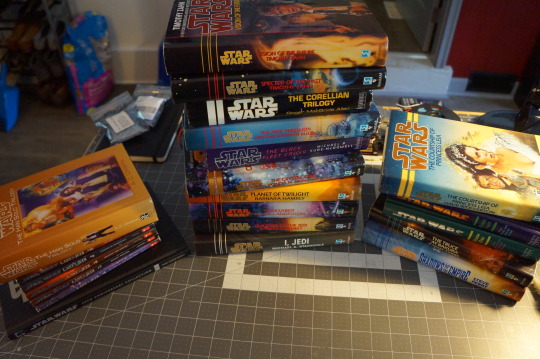
First off, I just want to point out that I don’t have every book he’s ever illustrated. Some of them are just harder than hard to find, are hilariously expensive, or I just don’t have an edition that features his art prominently - you’ll see what I mean. Right off the bat though, you can see that he was really hitting his stride in the mid-90′s, with all but a handful of these coming out between ‘94 & ‘99. One of the highlights from this time for me, is The Callista Trilogy.

I just want to stress that The Callista Trilogy is a highlight for me only because of its gorgeous cover art. 🤣 Other than that, this book series needs to go lay down.
Anyway, the designs are all really striking and even after all these years, absolutely iconic. And you can really see Struzan’s distinct visual style at play here; not a painting in the same vein as something from Dave Doorman, and not a simple trace. Rather, something that is stylized in a very particular, very subtle way, almost to the point where it appears photo-realistic at first glance. Beautiful.
Next up is this trio of trilogies (good use of words, me), collected in these Science Fiction Book Club (SFBC) hardcovers:
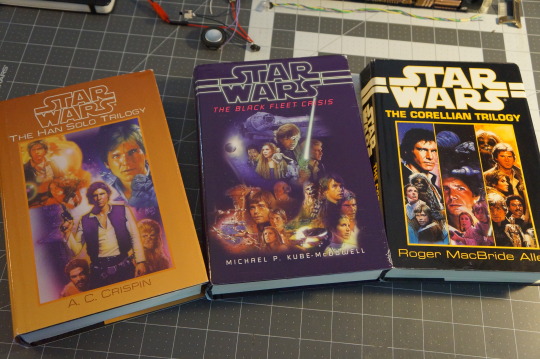
Once again, these covers are just striking, particularly The Black Fleet Crisis. This is actually what I was referring to when I said that I don’t always have the best editions for a Drew Struzan appreciation post. 😅
Because these are hardcover collections of paperback books, we actually miss out on a good bit of the art. For these SFBC special editions, the publisher just took all three and basically photoshopped the best bits of each one together. The one that suffers the most here is obviously The Corellian Trilogy, where they didn’t even try to blend everything together, and instead just separated everything into columns. I don’t personally mind it (and I do love having the hardcover editions of these books) but if you want to see the covers as they were originally intended, just pickup those mass market paperbacks. 🙂
There’s a lot more to get through, so I’ll just hit the highlights here; even though he didn’t illustrate The Thrawn Trilogy (that was Tom Jung, who I personally think did an okay-ish job at best), he did an absolutely amazing job with the follow-up, The Hand of Thrawn Duology in ‘98 & ‘99:
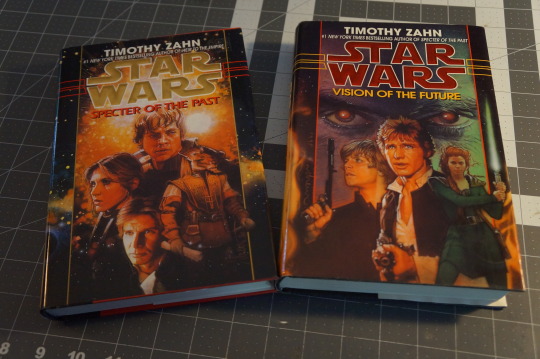
I’ve always loved these covers. And narratively speaking, they really do serve as one last hurrah on the Bantam Era. Oh, and also please note, Mara Jade on the cover of Vision of the Future, just as Zahn originally described her. ❤❤❤
If you step back and look at Struzan’s work as a whole, it’s all incredibly unified. I bring this up here because even though some of these are books relatively ‘meh’ worthy, Struzan maintained a level of quality that belied the mediocrity contained within. And also to say that he was definitely busy, particularly in 1994:
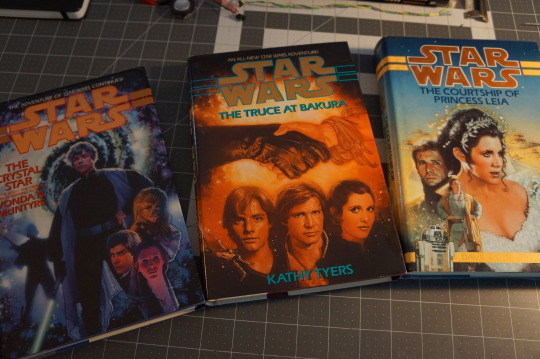
That’s right - all of these released in ‘94, within a few months of one another. These covers man… *chef’s kiss*
And look I’m sorry, I just can’t help myself: The Crystal Star was a hilarious joke until we all realized they were serious about it. 😳
Alright, that’s a little on the harsh side; it’s not nearly as bad as most make it out to be, and Waru as a source for unlimited power (citation needed 👀😉) isn’t any more ridiculous than the 50 other post-Palpy, hair-brained Imperial schemes that everybody else cooked up, so I guess it fits. And besides, I really wanna be nice to Vonda McIntyre here, but this book was just so so boring. 😴
*clears throat* Moving on, here we have a couple Barnes & Noble hardcover collections of The Jedi Prince Series:
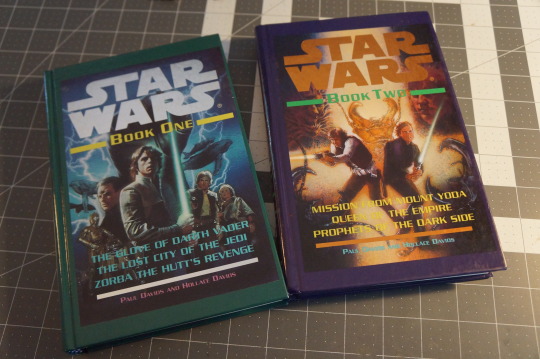
The same thing applies here; cover art photoshopped from across 6 different YA novels to get these. They don’t look bad, far from it. But rather this series has some things that people would rather forget about, namely a supposed son of Palpatine (spoiler: he wasn’t) named Triclops who had - wait for it - 3 eyes.
Like Tien. From DBZ. Yep. 🤦♂️
Moving further down the list, we have yet another pair of iconic cover designs, being I, Jedi (the only Star Wars novel written in the first person, and an appropriate riff on Isaac Asimov’s I, Robot - yes ladies & gentlemen, that is as clever as Star Wars gets) and The New Rebellion.

Classics, no doubt….but for reals, did anybody else ever wonder why the X-Wing on the cover of I, Jedi is missing an S-Foil? Or how that one slipped through??? 👀
Ah, at last we arrive at what is arguably Struzan’s most famous work; the covers for Shadows of the Empire & The Star Wars Trilogy: Special Edition.

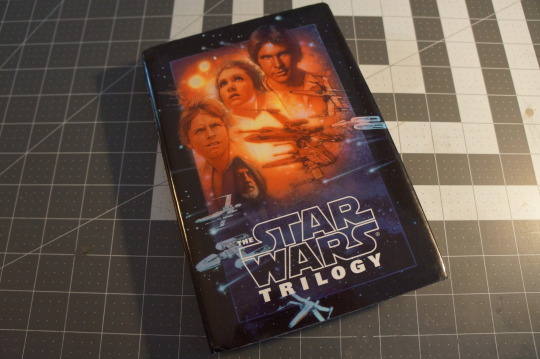
It’s hard to overstate just how important Shadows of the Empire really was for Star Wars as a brand. In an era where SW books were already extremely popular, the Shadows of the Empire Multimedia Project basically served as a breakout hit and reignited interest in SW media across the board. This was in no small part due to the striking imagery captured on its cover - are you seeing a pattern here?
This success actually renewed Lucas’ interest in a theatrical re-release of the OT in 1997….which of course, feature more beautiful art from Drew Struzan:
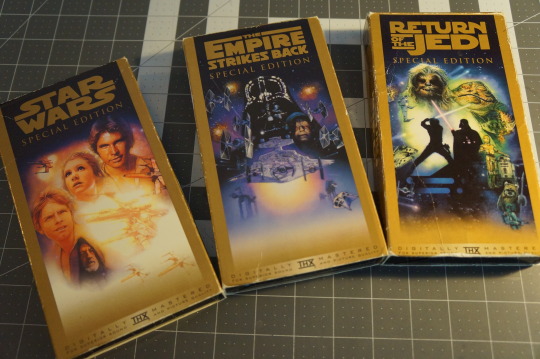
These are my OG Special Edition VHS tapes from back in the day. I watched these so damn much as a kid. In fact, they’re basically the whole reason that I’m here, annoying the shit out of everybody today. 😁
After the Bantam Era concluded & the Star Wars publishing license went to Del Rey, Struzan did progressively fewer pieces for SW media. Here we see his contribution for the latter half of the Last of the Jedi YA series, and his kick-ass cover art for the Darth Maul comic:
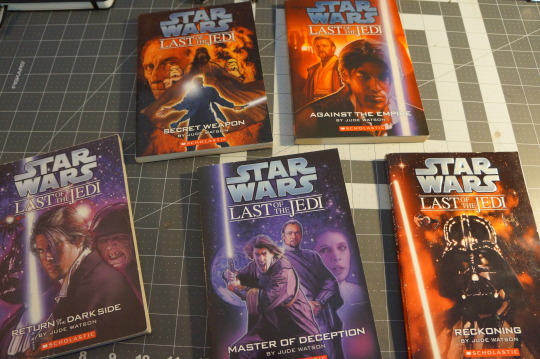
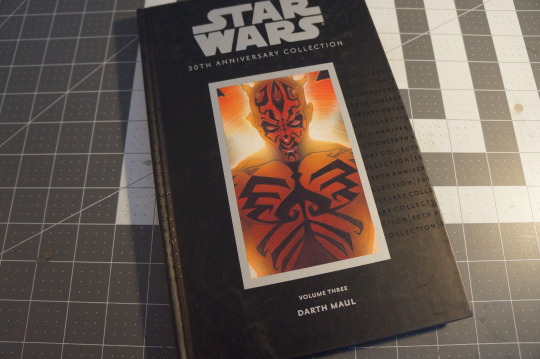
And when I say that Struzan did progressively fewer pieces for Star Wars, I am of course omitting his turn as the poster artist for the freaking Prequel Trilogy:
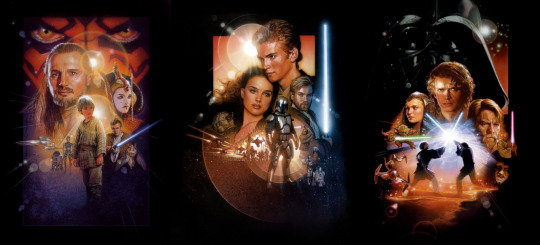
Say what you will about the films, but these poster designs are nothing short of genius.
Look guys, it would be pretty easy for me to downplay Struzan’s Star Wars portfolio as just one small part of his incredible career. But my dudes, this is literally just the tip of the iceberg. The man has been a professional illustrator for over 50 years, and his art has delighted and inspired generations. From Star Wars to Indian Jones, and from Back to the Future to Blade Runner - Drew Struzan has played an integral part in shaping popular culture.
Here’s to you, sir. 🍻
#star wars#drew struzan#art#the callista trilogy#the han solo trilogy#the black fleet crisis#the corellian trilogy#the hand of thrawn duology#the crystal star#the truce at bakura#the courtship of princess leia#the jedi prince series#i jedi#the new rebellion#shadows of the empire#the star wars trilogy#special edition#the last of the jedi#darth maul#comic#star wars prequel trilogy#the phantom menace#attack of the clones#revenge of the sith
124 notes
·
View notes
Text
LGBTQ Game Review - A Summer’s End – Hong Kong 1986
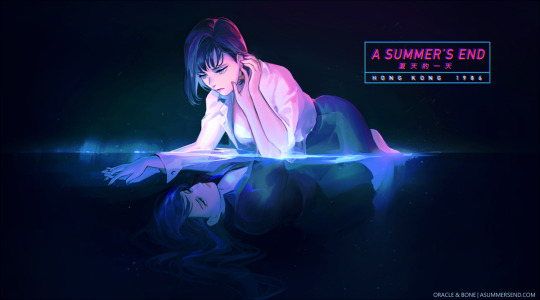
Before diving into the meat of Oracle and Bone’s A Summer’s End, I want to talk about the women behind this game Tida Kietsungden, and Charissa So. So and Kietsungden have done nothing but impress me since the announcement of A Summer’s End. They have repeatedly demonstrated their immense effort and dedication to creating a beautiful and thoughtful experience. Through conversations with the studio and reading their blog entries, I gained a remarkable understanding of how this game is both a tribute to classic cinema and a love letter to the Yuri and LGBT community. Through careful research and thoughtful expression, the two women navigate and acknowledge complicated issues, including Asian LGBTQ history and Hong Kong’s delicate political situation with grace and maturity. I am in complete awe of both women and their work. However, regardless of my profound respect for these creators, I still endeavor to offer my unfiltered thoughts on the visual novel, giving praise and criticism where appropriate.
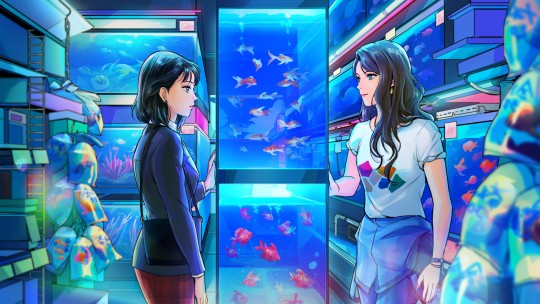
A Summer’s End – Hong Kong 1986 is a Yuri visual novel set, as you may have figured out, in Hong Kong in the year 1986. The game follows a young office worker, Michelle (Fong Ha) Cheung, who has a chance encounter with a free-spirited woman named Sam (Ka Yan) Wong. Both women feel drawn to each other, and the game explores this mutual attraction and the budding relationship which emerges from it.
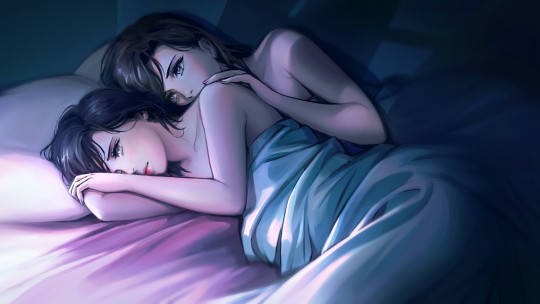
This plot follows the standard girl meets girl story that has permeated the Yuri genre for the past several decades. Like most Yuri stories, the older and more experienced woman, Sam, is rebellious and beautiful, with long dark hair and a dominating persona. Michelle, although far more naive in the ways of love, breaks the trend of this trope by being the more sullen of the two. I would have liked to see the game diverge a bit more from the standard story of the genre. Fortunately, A Summer’s End is a romance story between adults who do not work together, setting it apart from the norms. It even includes a coming out section that creates a more robust LGBT identity than any tale of temporary schoolgirl love.
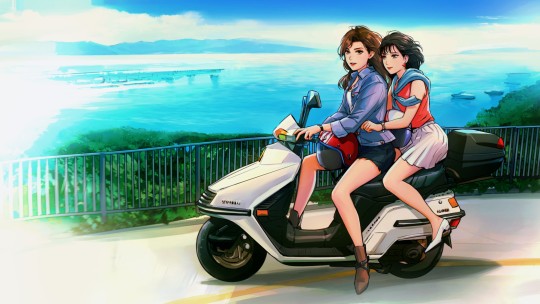
The story is well put together and well presented. The story is told primarily from Michelle’s perspective. It mostly takes place over a few days, during which Michelle engages in a whirlwind romance with Sam. This story features the struggle between her feelings and passion and her devotion to tradition and her mother. The progression of her affection is unrealistically fast. The story feels a bit rushed, and many of the societal and personal quagmires the game stumbles upon are not sufficiently developed or confronted. Had the game indulged in a more prolonged and tumultuous struggle for Michelle, conclusions would have felt much sweeter, and the story would have gone from good to great.
Even with this massive missed opportunity, there are plenty of exemplary moments and aspects of the narrative. The game pulls no punches addressing Michelle’s slightly overbearing mother and the conflict between the two. It would have been incredibly simple to take the easy route on this one. Still, the developers stuck to their guns and manage to explore a challenging situation satisfyingly, all while keeping the characters realistic and sympathetic. In fact, every scene relating to LGBT rights and history is flawlessly executed.
There are also some fantastic chapters, including a thrilling but refreshing bike ride and a flashback scene that recontextualizes certain events from another perspective. The many references and allusions to classic cinema including some older lesbian films and plenty of Asian works, are particularly noteworthy. However, the best part of A Summer’s End by far is the setting.
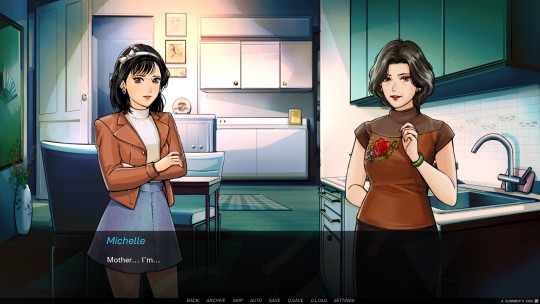
The location and time period is intrinsic to Sam and Michelle’s tale, as it is shaped by and reflects contemporary culture and LGBTQ rights. Oracle and Bone create a vibrant and lively world, a jaw-dropping depiction of Hong Kong in the 1980s. Everything helps feed into the creation of this world, including a fantastic and retro UI, small touches such as a Cantonese subway announcement, and objects encountered like a disposable camera help convey a strong sense of the period. However, the soundtrack sells it more than any other element, save perhaps the artwork, transporting the player to the era. While a few tracks are the standard easy listening affairs one expects from visual novels, there are tons of excellent city pop and disco beats, complete with plenty of synths and confidence! Finally, a visual novel soundtrack that contributes more than just background noise!
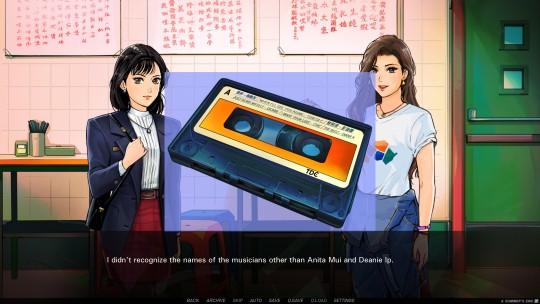
Sadly, the game’s dialogue choice system and branching paths are far more of a hindrance than a help. I can honestly say that the game would play better and be way more enjoyable as a kinetic novel. Most choices feel inconsequential, changing nothing of the story and resulting in almost the exact same response from other characters yet, they have a hidden points system. If you do not earn enough points, parts of the optional adult content will be unplayable until one goes back to find the right choice. I spent several hours replaying, and eventually skipping through, the game to unlock all the scenes, and finally gave up with one CG left unseen. The only choice with any actual effect is painfully evident in its consequences. One option leads to the bad ending, which is well written, but no reasonable player would go down that path unless they just wanted to see the whole game. The second unveils the true good ending, which no player in their right mind would not pursue, as again, the choice is obvious and adds nothing to the game. There is no reason to put in an alternative ending or tedious dialogue choice.
The characters in A Summer’s End are well constructed. Sam is adventurous without being obnoxious and has a mature though appropriately unrefined demeanor. Michelle is extremely curt and somewhat distant, although she displays a sharp wit and more timid nature on occasion. Both women participate in engaging, deep, and thoughtful discussions, often with each other, although sometimes internally, and thus feel well developed and complex. Unfortunately, their chemistry, while not absent, is not enough to sell the whirlwind romance. There is insufficient expression of their feelings and attractions, both internally or through dialogue and actions, so their inevitable closeness feels unearned.

However, even in the short game, both characters change with each other, especially Michelle, as she becomes more affectionate, confident, and caring. She begins to embody some of Sam’s warmness while never losing herself. Some of my favorite dialogue and interaction came from her towards the end of the game, although I will not spoil it. Additionally, side characters have a strong presence thanks to their firmly established characteristics and a profound effect on the narrative. Each has their own sprite and mannerisms, helping cement them as fixtures in A Summer’s End rather than tacked on assets.
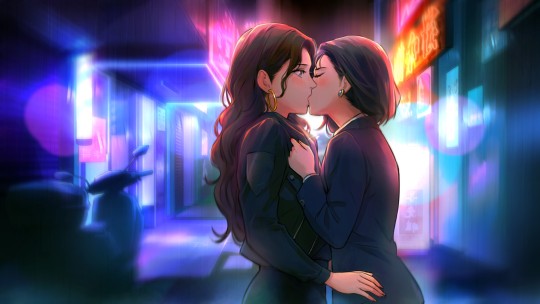
The visual novel contains optional adult content, which is installed in an extra patch and can be toggled on and off. I played through the game with and without it and can happily report that the story is just as fulfilling and complete without it. Although the unlockable nature of these scenes is aggravating, they are very well written and sensual without being exploitative. There were moments I did not care for as much, such as Sam getting carried away at one point, but it felt very realistic and incredibly sensual. The artwork in these sexual encounters is some of the best in the game, embracing darker colors and showcasing intense desire.
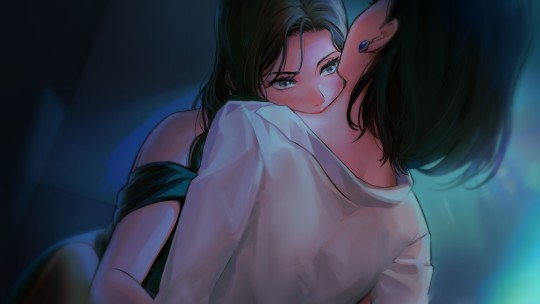
Speaking of the artwork, it is stupendous. The game is bright and striking, with amazing backgrounds complete with luminous neon signs, glaring televisions, and life and activity oozing from every corner. The backgrounds are so beautiful and detailed they could effectively serve in place of CG art, although there is plenty of that asides. The character models and designs are similarly excellent, with expressive poses and faces. The various outfits, of which the game has many, embody iconic 80’s fashion. Artist Tida Kietsungden draws both the characters and CGs with a distinctive hand-drawn style, which allows them to play well off each other and add to the beautiful presentation. The detail and care that went into the aesthetics are enormous and elevate the game at every moment.

A Summer’s End – Hong Kong 1986 is a vibrant and intimate experience. The fantastic setting and flawless artwork surround a compelling and thoughtful story about lesbian love and desire, societal expectations, and the bonds between family and lovers. It is rough around the edges, with a slightly rushed story that leaves little time to wallow in complexity and an awful dialogue system. However, it will win players over with its striking presentation and sophisticated subject matter. I look forward to more from this studio and highly recommend you check this game out!
Ratings:
Story – 7
Characters – 6
Art – 10
Music – 8
LGBTQ – 8
Sexual Content – 3 (8 with patch)
Final – 7
Purchase A Summer’s End on Steam and itch.io, available April 23
Consider supporting Yuri news, reviews, and content on the YuriMother Patreon
#Yuri#lgbt#lgbtq#lgbtq+#queer#gay#reivew#a summer's end#hong kong#girls love#gl#wlw#lesbian#visual novel#games#video games#gaming#manga#anime#reviews
2K notes
·
View notes
Text
Life is Strange: True Colors
Leading up to the release of Episode 1 of TellTale's The Walking Dead game, I was working freelance for GameRevolution at the time, lived in the area, and had the chance to play a build of the game to write a preview on it. I remember comparing it to Mass Effect because, at the time, there just...weren't games of that subgenre. Of course, by now we've seen an explosion of this type of game - the 'narrative/choice-driven game,' spearheaded and even oversaturated by Telltale to their own demise.
Out of all of the games that have come from that initial boom, Life is Strange by DontNod was and still is the most influential on my life, but I also have always harbored really conflicted feelings about it - especially with how it resolved its narrative. Hell, if you're reading this, you're probably aware that I spent a few years of my life creating a sequel fanstory which I even adapted a chunk of into visual novel format. Hundreds of thousands of words, days and days of life spent essentially trying to process and reconcile my conflicted feelings about this game's conclusion(s). Since then, I've been experimenting with interactive fiction and am currently developing my own original visual novel using everything I've learned from both creating and playing games in this genre. It's a subgenre of game I have a lot of interest and passion for because, when handled well, it can allow a player to sort of co-direct a guided narrative experience in a way that's unique compared to strictly linear cinematic experiences but still have a curated, focused sense of story.
Up until this point, I've regarded Night in the Woods as probably the singular best game of this style, with others like Oxenfree and The Wolf Among Us as other high marks. I've never actually put any Life is Strange game quite up there - none of them have reached that benchmark for me, personally. Until now, anyway.
But now, I can finally add a new game to that top tier, cream of the crop list. Life is Strange: True Colors is just damn good. I'm an incredibly critical person as it is - and that critique usually comes from a place of love - so you can imagine this series has been really hard to for me given that I love it, and yet have never truly loved any actual full entry in it. I have so many personal issues, quibbles, qualms, and frustration with Life is Strange: with every individual game, with how it has been handled by its publisher (my biggest issue at this point, actually), with how it has seemingly been taken away from its original development studio, with how it chooses to resolve its narratives...
But with True Colors, all of those issues get brushed aside long enough for me to appreciate just how fucking well designed it is for this style of game. I can appreciate how the development team, while still clearly being 'indie' compared to other dev teams working under Square-Enix, were able to make such smart decisions in how to design and execute this game. Taken on its own merits, apart from its branding, True Colors is absolutely worth playing if you enjoy these 'telltale' style games. Compared to the rest of the series, I would argue it's the best one so far, easily. I had a lot of misgivings and doubts going in, and in retrospect, those are mostly Square-Enix's fault. Deck Nine, when given the freedom to make their own original game in the same vein as the previous three, fucking nailed it as much as I feel like they could, given the kinds of limitations I presume they were working within.
I'm someone who agonizes every single time there is news for Life is Strange as a series - someone who essentially had to drop out of the fandom over infighting, then dropped out of even being exposed to the official social media channels for it later on (I specifically have the Square-Enix controlled channels muted). I adore Max and Chloe, and as a duo, as a couple, they are one of my top favorites not just in gaming, but in general. They elevated the original game to be something more than the sum of its parts for me. And while I have enjoyed seeing what DontNod has made since, it's always been their attention to detail in environmental craftsmanship, in tone and atmosphere, which has caught my interest. They're good at creating characters with layers, but imo they've never nailed a narrative arc. They've never really hit that sweet spot that makes a story truly resonate with me. Deck Nine's previous outing, Before the Storm, was all over the place, trying to mimic DontNod while trying to do its own things - trying to dig deeper into concepts DontNod deliberately left open for interpretation while also being limited in what it could do as a prequel.
But with True Colors, those awkward shackles are (mostly) off. They have told their own original story, keeping in tone and concept with previous Life is Strange games, and yet this also feels distinctly different in other ways.
Yes, protagonist Alex Chen is older than previous characters, and most of the characters in True Colors are young adults, as opposed to teenagers. Yes, she has a supernatural ability. And yes, the game is essentially a linear story with some freedom in how much to poke around at the environment and interact with objects/characters, with the primary mechanic being making choices which influence elements of how the story plays out. None of this is new to the genre, or even Life is Strange. But the execution was clearly planned out, focused, and designed with more caution and care than games like this typically get.
A smaller dev team working with a budget has to make calls on how to allocate that budget. With True Colors, you will experience much fewer locales and environments than you will in Life is Strange 2. Fewer locations than even Life is Strange 1, by my count. But this reinforces the game's theming. I suspect the biggest hit to the game's budget was investing in its voice acting (nothing new for this series) but specifically in the motion capture and facial animation.
You have a game about a protagonist trying to fit in to a small, tightly knit community. She can read the aura of people's emotions and even read their minds a little. And the game's budget and design take full advantage of this. You spend your time in a small main street/park area, a handful of indoor shops, your single room apartment. It fits within a tighter budget, but it reinforces the themes the game is going for. Your interactions with characters are heightened with subtle facial cues and microexpressions, which also reinforces the mechanic and theming regarding reading, accepting, and processing emotions. And you get to make some choices that influence elements of this - influenced by the town, influenced by the emotions of those around you, which reinforce the main plot of trying to navigate a new life in a small town community.
When I think about these types of games, the conclusion is always a big deal. In a way, it shouldn't be, because I usually feel it's about the journey, not the destination. And as an example, I actually really dislike the ending of the original Life is Strange. I think it's a lot of bullshit in many ways. The setpiece is amazing and epic, sure, but the actual storytelling going on is...really hollow for me. Yes, the game does subtly foreshadow in a number of ways that this is the big choice it's leading up to, but the game never actually makes sense of it. And the problem is, if your experience is going to end on a big ol' THIS or THAT kind of moment, it needs to make sense or the whole thing will fall apart as soon as the credits are rolling and the audience spends a moment to think about what just happened. When you look at the end of Season 1 of Telltale's The Walking Dead, it's not powerful just because of what choice you're given, but because through the entire final episode, we know the stakes - we know what is going to ultimately happen, and we know the end of the story is fast approaching. All of the cards are on the table by the time we get to that final scene, and it works so well because we know why it's happening, and it is an appropriate thematic climax that embodies the theming of the entire season. It works mechanically, narratively, and thematically, and 'just makes sense.'
The ending of Life is Strange 1 doesn't do that, if you ask me. The ending of most games in this genre don't really hit that mark. When I get to the end of most game 'seasons' like this, even ones I enjoy, I'm typically left frustrated, confused, and empty in a way.
The ending of True Colors, on the other hand, nails everything it needs to. Handily, when compared to its peers.
If you're somehow reading this and have not played this game but intend to, now is probably where you should duck out, as I will be
discussing SPOILERS from the entire game, specifically the finale.
.
.
.
.
.
.
.
Firstly, since I don't know where else to put this, some criticisms I found with the game. And honestly, they're all pretty damn minor compared to most games of this type.
Mainly, I just wish the whole Typhon thing was handled a bit more deliberately. It's a bit weird to do the 'big evil corporation' thing (especially when a big corporation like Square Enix occupies as much as or even more of the credits to this game than the people who actually MADE it?) without offering more explanation and subtlety. The game certainly makes some efforts but they're mostly small and mostly optional, like background chatter or a handful of one-off bits of documentation/etc. you can find in the environment. I feel like Diane in particular needed to be fleshed out just a little bit more to really sell us on how and why things like this happen, why corporations make decisions that cost people their happiness, security, and lives and they just get to keep on doing it. I think just a little bit that is unavoidable to the player that puts emphasis on maybe how much the town relies on the money/resources Typhon provides would've helped. Again, this is minor, but it stands out when I have so little else to critique.
I would've liked to get more insight on why Jed is the way he is. No, I don't think we really needed to learn more about his backstory, or even really his motivations. I think we get enough of that. I just think it would've been great to somehow highlight more deliberately how/why he's built up this identity overtop of what he's trying to suppress. Maybe even just having Alex internally realize, "Wait, what the hell, Jed has been hiding these emotions and my powers haven't picked up on it?" or something to that effect could have added an extra oomph to highlight how Jed seems to be coping with his emotions by masking/suppressing them. Also really minor complaint, but again...there's not much else here I can think to really improve on within the confines of what's in the game.
The game doesn't really call Alex's power into question morally. Like. Max has an entire meltdown by the end of her story, second-guessing if she's even helped anyone at all, if she has 'the right' to do so, how her powers might be affecting or expressing her own humanity and flaws...this story doesn't really get into that despite a very similar concept of manipulating others. There's like one bit in a document you can choose to read in Alex's 'nightmare' scene, but that's really it. I feel like this sentiment and how it's executed could have easily been expanded upon in just this one scene to capture what made that Max/Other Max scene do what it did in a way that would address the moral grayness of Alex's powers and how she uses them, and give players a way to express their interpretation of that. Also, very small deal, just another tidbit I would've liked to see.
When I first watched my wife play through Episode 5 (I watched her play through the game first, then I played it myself), I wasn't really feeling the surreal dreamscape stuff of Alex's flashbacks - which is weird, because if you're read my work from the past few years, you'll know I usually love that sort of shit. I think what was throwing me off was that it didn't really feel like it was tying together what the game was about up until that point, and felt almost like it was just copying what Life is Strange did with Max's nightmare sequence (minus the best part of that sequence, imo, where Max literally talks to herself).
But by the time I had seen the rest of the story, and re-experienced it myself, I think it clicked better. This is primarily a story about Alex Chen trying to build a new life for herself in a new community - a small town, a tightly knit place. Those flashbacks are specifically about Alex's past, something we only get teeny tiny tidbits of, and only really if we go looking for them. I realized after I gave myself a few days to process and play through the game myself that this was still a fantastic choice because it reinforces the plot reasons why Alex is even in the town she's in (because her father went there, and her brother in turn went there looking for him), and it reinforces the theme of Alex coming to accept her own emotions and confront them (as expressed through how the flashbacks are played out and the discussions she has with the image of Gabe in her mind, which is really just...another part of herself trying to get her to process things).
By the time Alex escapes the mines and returns to the Black Lantern, all of the cards are on the table. By that point, we as the audience know everything we need to. Everything makes sense - aside from arguably why Jed has done what he has done, but put a pin in that for a sec. We may not know why Alex has the powers she does, but we have at least been given context for how they manifested - as a coping mechanism of living a life inbetween the cracks of society, an unstable youth after her family fell apart around her (and oof, trust me, I can relate with this in some degree, though not in exactly the same ways). And unlike Max's Rewind power, the story and plot doesn't put this to Alex's throat, like it's all on her to make some big choice because she is the way she is, or like she's done something wrong by pursuing what she cares about (in this case, the truth, closure, and understanding).
When Alex confronts Jed in front of all of the primary supporting characters, it does everything it needs to.
Mechanically: it gives players choices for how to express their interpretation of events, and how Alex is processing them; it also, even more importantly, uses the 'council' as a way of expressing how the other characters have reacted to the choices the player has made throughout the game, and contributes to how this climax feels. We're given a 'big choice' at the end of the interaction that doesn't actually change the plot, or even the scene, really (it just affects like one line of dialogue Alex says right then) and yet BOTH choices work so well as a conclusion, it's literally up to your interpretation and it gives you an in-game way to express that.
Thematically: the use of the council reinforces the game's focus on community; and the way the presentation of the scene stays locked in on Alex and Jed's expressions reinforces its focus on emotion - not to mention that the entire scene also acts as a way to showcase how Alex has come to accept, understand, and process her own emotions while Jed, even THEN, right fucking at the moment of his demise, is trying to mask his emotions, to hide them and suppress them and forget them (something the game has already expressed subtly by way of his negative emotions which would give him away NOT being visible to Alex even despite her power).
Narratively: we are given a confrontation that makes sense and feels edifying to see play out after everything we've experienced and learned. We see Alex use her powers in a new and exciting way that further builds the empowering mood the climax is going for and adds a cinematic drama to it. No matter what decisions the player makes, Alex has agency in her own climax, we experience her making a decision, using her power, asserting herself now that she has gone through the growth this narrative has put her through. Alex gets to resolve her shit, gets to have her moment to really shine and experience the end of a character arc in this narrative.
Without taking extra time to design the game around these pillars, the finale wouldn't be so strong. If they didn't give us enough opportunities to interact with the townspeople, their presence in the end wouldn't matter, but everyone who has a say in the council is someone we get an entire scene (at least one) dedicated to interacting with them and their emotions. If they didn't implement choices in the scene itself, it would still be powerful but we wouldn't feel as involved, it'd be more passive. If they didn't showcase Alex's power, we might be left underwhelmed, but they do so in a way that actually works in the context through how they have chosen to present it, while also just tonally heightening the climax by having this drastic lighting going on. If they didn't have the council involved, we'd lose the theming of community. If they didn't have the foil of Alex/Jed and how they have each processed their emotions, we'd miss that key component. And if we didn't have such detailed facial animations, the presentation just wouldn't be as effective.
Ryan/Steph are a little bit like, in this awkward sideline spot during the climax? Steph always supports you, and Ryan supports you or doubts you conditionally, which is unsurprising but also ties into the themes of Ryan having grown up woven into this community, and Steph being once an outsider who has found a place within it. They're still there, either way, which is important. The only relevant characters who aren't present are more supporting characters like Riley, Ethan, and Mac. Ethan being the only one of those who gets an entire 'super emotions' scene, but that also marks the end of his arc and role in the story, so...it's fine. Mac and Riley are less important and younger, as well, and have their own side story stuff you have more direct influence on, too.
But damn, ya'll, this climax just works so well. It especially stands out to me given just how rarely I experience a conclusion/climax that feels this rewarding.
And then after that we get a wonderful montage of a theoretical life Alex might live on to experience. Her actions don't overthrow a conglomerate billionaire company. She doesn't even save a town, really. If the entire council thinks you're full of shit, Jed still confesses either way - because it's not up to the council whether he does this, it's because of Alex, regardless of player choice. Honestly, even after a playthrough where I made most choices differently from my wife, there weren't really many changes to that montage at the end. It'd have been great if it felt more meaningfully different, but maybe it can be. Even if not, the design intent is there and the execution still works. It's a really nice way to end the story, especially since it's not even a literal montage but one Alex imagines - again, her processing what she's gone through, what she desires, expressed externally for us to see it.
And for once, the actual final 'big decision' in a game of this type manages to be organic, make sense, and feel good and appropriate either way. You choose to either have Alex stay in Haven Springs and continue building her life there, or you can choose to have her leave and try to be an indie musician, with the events of the game being yet another chunk of her life to deal with and move on from (I haven't really touched on it, but music, especially as a way to express and process emotions, is a recurring thing, much like photography was in the original game, or Sean's illustrations in LiS2). For once, a climactic 'pick your ending' decision that doesn't feel shitty. It's pretty rare for this genre, honestly.
I could - and already have, and likely will - have so much more to say about this game and its details, but I really wanted to focus on touching upon a main element that has left me impressed: the way the entire game feels designed. It feels intentionally constructed but in a way that reinforces what it is trying to express as a story. It's not just trying to make people cry for the sake of 'emotions.' It is a game literally about emotions and it comes to a conclusion in a way that is clearly saying something positive and empowering about empathy and self-acceptance.
Storytelling is a craft, like any other, and it entails deliberate choices and decisions that can objectively contribute to how effective a story is for its intended audience.
A good story isn't something you find, after all.
It's something you build.
18 notes
·
View notes
Photo

3D Visualization Company- 5 Specializations of Archteriorbd
Any business regardless of whether it's development, a real home, web-based retailing, or an item chart needs magnificent visuals. Photorealistic pix turn out flawless for promotion missions and inventories, and they are certainly vital for item chart endorsement. Likewise, if a draftsman or inside style fashioner doesn't have great pictures, it's plainly impractical for them to convince purchasers with straightforward expressions or freehand representations.
Along these lines, clients face a longing — to lease a 3D visualization office or go for standard photography. The last one, notwithstanding, is presently not typically a choice. Particularly, with regards to compositional activities, indoor plans, or the dispatch of another item. Normally, assuming the task has not, at point been completed at this point, there's nothing a photographic artist can do. Thus, planners, inside architects, and makers flip to a 3D delivering association to get astonishing computerized visuals for their activities.
In any case, what sort of archteriorbd supplier a genuine 3D visualization organization can give their customers? Indeed, there's a posting of 5 acclaimed CG alternatives that a multi-trained 3D studio needs to give.
#1. Structural 3D Visualization
Structural 3D delivering is a photorealistic CG symbolism of development and its environmental factors. To make astonishing renders, all 3D compositional visualization enterprises are going through indistinguishable degrees — first, 3D displaying, finishing, and lighting, and afterward, 3D delivering.
3D craftsmen start with building up an assigned 3D life-sized model of development and variables of its current circumstance. They can region development in the focal point of a lavish display or a town downtown, depending on the undertaking. From that point onward, 3D modelers add figures of individuals, creatures, vehicles, and so forth, to add elements and pass on ways of life to the picture. Also, eventually, they adjust the sky and light sources to beautify the introduction and make them all-out photographs even extra photorealistic.
As per the customer's vision, 3D specialists can make extra normal or emotional 3D renderings. If a designer wishes it more prominent dynamite, modelers can choose an unexpected point, set up stunning lights and amazing environmental factors. Or on the other hand the other way around, they can make additional quiet and unprejudiced environmental factors to the focal point of consideration customers' advantage in the actual development.
The cutting-edge 3D programming program gives creative channels that can cause compositional visualization to appear to be a pencil drawing or watercolor painting. With these picks within reach, engineers can pick explicit introduction designs for interesting obligations and crowds. Say, to get undertaking endorsement from the financial backers, it's higher to utilize photorealistic visualizations. Nonetheless, imaginative channels may also turn out perfectly for web-based media promoting.
To get compositional 3D delivering administrations, a modeler should transport a 3D visualization business venture a full short. The snappy needs to comprise of all undertaking significant focuses — a website page plan, ground designs, fabric sheets, lights prerequisites, photographs, references, and so on From that point forward, all they need to do is to sit tight for the outcome.
#2. Inside 3D Rendering
Inside 3D visualization is a photorealistic introduction of the indoor zones of the house. The incredible inside render passes on all surfaces, materials, and apparatuses parcels with the best fulfillment and goal.
To make indoor visualization, 3D craftsmen begin with building up every one of the parts principally dependent on 2D deck plans. At that point, they are every one of the home windows and entryways, as pleasantly as add design factors like sections, curves, steps, and so on The resulting step is they embed 3D designs of goods and stylistic theme into the inside and practice surfaces on all surfaces. From that point onward, 3D experts set up cameras and lighting apparatuses for 3D delivery.
The inside gentle couldn't possibly be more significant — it's particularly imperative in private designs that need to appear to be roomy and agreeable. Normally, 3D specialists make two visualizations with every daytime and night gentle to display that the house seems outstanding with every natural and engineered lighting.
To get indoor CGI delivering, planners should send the 3D visualization company a ground plan, decorations design, lights plan, roof plan, divider rises, a posting of materials. One can moreover add pictures and 3D pics as references. To put it plainly, the more full is concise, the snappier the 3D office will make 3D visualization.
#3. Item 3D Visualization
Item 3D visualization is significant for promotion crusades, on the web, and disconnected publicizing, lists, SMM, etc. To make the purchaser's coronary heart beating from the main look, item photos should flaunt the things most everything being equal and temptingly. Today, 3D has almost changed ordinary pictures because the reality master 3D item visualization enterprises can make CGI with indistinguishable photorealistic incredible anyway in the most imaginative manners.
Experienced 3D craftsmen perceive how to develop the right 3D life-sized model of the favored first-rate and set up substances to gain the photorealistic look. Not exclusively do they have monstrous libraries of surfaces and substances anyway can moreover make an altered one if necessary. In this way, they will make heavenly visualization for even the most muddled and unique plans.
Additionally, a legitimate 3D visualization manager has a great deal of instant 3D roomsets — from city insides to remarkable scenes. Subsequently, 3D craftsmen can execute however many different lifestyles standards as could be allowed. They basically are an item 3D life-sized model in any sort of environmental factors and substitute to an instant 3D scene in a couple of snaps to get a new landscape.
To arrange item 3D delivery from a 3D organization, business people need to give assigned drawings of the item, pics of a model or practically identical thing, as appropriately as representations, hand-drawings, temper sheets, etc.
#4. Liveliness
As per insights, 68% of individuals decide to analyze another item or supplier utilizing taking a gander at a brisk video. In this way, it's nothing unexpected that movement turns out faultlessly for any of the before-referenced enterprises.
For structure and real property promoting, a 3D boss can make a flythrough activity around a structure. For a higher introduction of the insides, one can arrange a walkthrough video for every one of the rooms. What's more, for item format and internet business, it's basic to have item liveliness that shows objects available to be purchased in real life.
A very much rumored 3D visualization association has a different part of 3D craftsmen who have practical experience in making movement. Contingent upon the endeavor and customer's inclinations, they can make each concise quiet film or make a film-like activity with subtitles, a voiceover, and shocking music.
To arrange an activity, purchasers need to give a 3D company a horrendous parcel of measurements and substances on the endeavor as could be expected. These should be content, drawings, instant 3D models, references on activity, and so forth
#5. Computer-aided design & BIM Services
A totally far-located 3D visualization business undertaking also has a gathering of CAD experts because the reality 3D and 2D alternatives continually go inseparably. No check number if it's architecture, inside, or item configuration, all undertakings need the right CAD drafts. Without them, it will be definitely impractical to make an item and uphold a structure project.
Modelers and inside fashioners can arrange site online plans, ground plans, decorations format, segments, divider heights. Concerning producers, a 3D office can supply unmistakable millwork and keep drafts.
Likewise, some 3D studios give BIM or developing records displaying. A BIM life-sized model of development it's not, at this point basically a 3D item anyway an information unit that comprises a multitude of records about the undertaking. To lay it out plainly, BIM has information on each little issue that building comprises of.
Each unit in the BIM model controls its own special information, for example, the charge per unit. For even additional comfort, each BIM segment has a place with a novel Family — Furniture, Plumbing, Roofs, Pipes, etc. Hence, if makers like to build the market, they should outfit downloadable BIM models of their apparatuses and home gear on the site. The segment is, having prepared to-utilize BIM styles close by, modelers and inside fashioners most presumably will utilize them for their undertakings. Subsequently, a little financing in BIM can considerably expand the pay of the brand.
If you need any sort of CG symbolism, find a multi-discipline 3D visualization association with appropriate standing. A particularly 3D studio can expertly execute shocking 3D delivering, explicit 2D CAD drafts, and even outstanding BIM. Presumably, they have every one of the sources to supply first-class benefits, which incorporate present-day equipment, cutting-edge programming, and a huge group of specialists.
If need any architectural help or any architecture service.
Visit our site 👉architectural 3d visualization
2 notes
·
View notes
Note
tell me about surge concerto!
Send me questions about my character’s series

hoo boy where to start here
So, for the textbook definition, Surge Concerto is a smaller series of games hailing from the EXA_PICO universe of games! If you’ve ever heard of an obscure RPG series called “Ar Tonelico”, it’s loosely connected to that! (Very loosely, actually, so no prior knowledge of it is really required)
As of this posting, there are really only two games in the series: Ciel Nosurge, released in 2012 for the PS Vita, and its sequel Ar Nosurge, released in 2014 for the PS3–and later in 2015 as a deluxe rerelease for the PS Vita, Ar Nosurge Plus.
Without getting into it a huge amount, Surge Concerto is a game with a really heavy basis on story above anything else. Ciel Nosurge is a full visual novel/life-simulator game, while Ar Nosurge is a visual novel wearing the skin of a (decently fun) JRPG.
The games feature a consistent, varied cast of characters. And while they are occasionally the victims of some rather annoying pandering (I think most of you can assume what I mean when I use this word), I honestly feel like the cast of Surge Concerto may be one of the best, most believable, and fleshed-out casts of characters I’ve encountered in a while! And if you’ve noticed I’ve referred to Earthes as “the player”, yeah–you, the person at the controller hitting buttons–are treated as an entity in the story in a rather engaging spin on the idea I’ve only ever seen in maybe a few other games; in a sense that only serves to enhance the game’s immersion, at that.
The world is also incredibly fleshed out, with expansive lore and actual, detailed in-universe systems of science and Song Magic! And if you assumed the latter was just something said for show, no–
Song Magic is an act of “show, don’t tell” put to the absolute extreme, to the point it features two entire in-universe languages. Both of which have official syntax and grammar materials available for the public, as well as a rather lengthy dictionary, which the community has lovingly translated.

If all this sounds like a lot, yeah–it kinda is, which is one minor problem it suffers. That being said, I’d highly advise getting into it if you have the time or interest to invest! It’s well-worth it, in my opinion!
The series can feel a bit hard to approach if you just go at it blindly, so I’ll provide a short little introduction/primer below if anyone here wants to get started!
First, you have to start with Ciel Nosurge. While you can start at Ar Nosurge, I would not recommend it. The events of Ar Nosurge are written almost purely as a climax to the events of Ciel Nosurge, so almost all of the impact of it is lost if you don’t know what happened prior.
Ciel Nosurge

The basic premise of Ciel Nosurge is that you (yes, YOU, the player) somehow connect to a newly built monitor in the home of a girl named Ion. After some introductions and dialogue choices, you learn that she has amnesia and that, for some reason, the device in your hands (a PS Vita; just roll with it) has the ability to help her restore her memories. What follows is a VERY LONG visual novel/life simulator, where you go through Ion’s memories with her–learning of the planet “Ra Ciela” and the troubles it faces. Aside from that, there’s the mystery of where Ion is, and why only she and some woman named “Nelico” are the only ones around.
The game was never officially localized, but this fanbase is dedicated beyond belief, so there exists a fully subtitled and translated playlist of the game’s main story (with important side events included as would be appropriate). This covers pretty much everything you’d need to know to move into Ar Nosurge, and is how I got into the series! It’s about 50+ hours long so, uh. Watch it at your own pace! ;v;
There is work on a translation of the offline version of the game, but it’s ongoing and could take a while. For now, the playlist is the most readily available option to experience the story!
With that, let’s move into Ar Nosurge!
Ar Nosurge

As I mentioned before, Ar Nosurge acts as the “climax” to Ciel Nosurge’s “setup”! Set after a rather lengthy time jump between games, Ar Nosurge’s plot focuses on giving closure to a number of established and unresolved plot threads set up in Ciel Nosurge. The game shifts control between two pairs of player characters, with one side starring Delta Lantanoil, a previous character who showed up in Ciel Nosurge, and the other focusing on Earthes (oh hello), a robot who accompanies Ion as she continues the plot threads from the previous game. The identity of Earthes actually changes depending on whether you have a save file from Ciel Nosurge–if you have one, then Earthes is the same player who connected with and helped Ion from Ciel Nosurge; if not, the story treats you as someone else who connected to the terminal after a certain “event” happens at the end of Ciel Nosurge.
(Unfortunately, the game kind of botches this system in the localization, so I find it’s usually best to just pretend Earthes is the same person no matter where you go. Anyways!)
All this aside, Ar Nosurge is a lot easier to get ahold of than Ciel Nosurge, since for some reason it was localized by itself! It’s available on PS3 and PS Vita, although I personally recommend the PS Vita version, as it features more content and adds in a number of dialogue options that were bizarrely missing in the localized PS3 version (leaving only dialogue options that, for one particularly important scene, DRASTICALLY CHANGE THE CHARACTER OF EARTHES. And NOT FOR THE BETTER.) So if you can, I would highly advise trying your best to get ahold of the Vita version, Ar Nosurge Plus, or watching a playthrough of it if that isn’t an option. Not terribly enticing options, but again, the omissions made in the PS3 version very nearly turned me off from the game’s story, so unless you have tolerance for that sort of thing, I’d recommend the above.
Anyways, yeah! I think that covers most of what I have to say. There are other official materials present regarding the game, some of which have been fan-translated and some of which have not, but if you go through the main content, you really should have the basic idea!
I thank those of you who’ve read through this entire thing, and I hope you consider getting into this series! I love it a lot, and I hope maybe you can learn to love it too!
#meme friday#arboridasprodigy#[wow this turned into a long essay]#[still i hope some of you go through it and are maybe interested!]#[maybe spread the word if you'd like ;v;]#arboriasprodigy
17 notes
·
View notes
Text
Five Top 4's
I was asked by a friend to share some of my favorite media, so this post is a list of my personal favorite Books, Video Games, Board Games, Movies, and etc. Perhaps this will give you some insight into my creative tendencies, or perhaps it will just be a good opportunity for you to comment and agree/disagree/discuss with me!
Originally this was going to be a top 5 list, but I found myself with 4 obvious answers, and struggling to name a fifth in each category. So I just made it top 4—if it didn’t come to mind immediately, then it doesn’t really deserve that recognition, after all. Without further ado, here goes!
Top 4 Books
Rumo & His Miraculous Adventures - I love all of Walter Moers’ books, and if you haven’t read this author’s work before, you’re really missing out. The Zamonia series builds a wonderland-like world where whimsical species live in harmony with one another.
Good to Great - My favorite business manual. Good to Great showcases what specific elements of leadership, discipline, focus, and culture contribute to success. It’s something I’ve worked tirelessly to replicate in the offices of Level 99 Games.
The Meditations of Marcus Aurelius - One of the most influential philosophy books for me, the Meditations is a classic that instructs the reader in a calm, measured approach to life and its challenges. Much of the book deals with overcoming fear and the internal challenges that are formative to us all in growing up.
Blazing Aces: A Fistful of Family Card Games - Perhaps the best game-related book I own. Reiner Knizia turns a standard deck of playing cards on its head and uses it to play 15 stunningly original games, all based around the evaluation of Poker hands. If you want to see a real master of the game design genre at work, this is the book to get.
Top 4 Board Games
Libertalia - This game is an incredible feat of design, and it combines the simultaneous selection of games like BattleCON and Exceed with a clean resolution system and mechanics that make it appropriate for up to 6 players. The style of the game is excellent, and the mechanics lead to interesting, loaded choices every single turn. This is one game I always want to show my friends, and its something that I would recommend to players of any skill level.
Magical Athlete - Magical Athlete is not at all what we would define as a “modern” game. However, I never fail to have fun with friends when I pull this out and bring it to the table. I keep a copy in the office to remind myself that it’s important not to get too caught up on high-concept mechanics and high-budget art—all this is merely in service to fun, which can be achieved just as easily with simple mechanics and whimsical gameplay.
Dominion - Dominion is one of the most influential board games on my own personal style, and is the game that, to me, signals the temporal and stylistic break between the classic hobby games and modern ones. The incredible amount of modular content generated by shifting setups inspired the many variables present in games like BattleCON and Exceed.
Unlock Adventures - Evocative and interesting without being overwrought, Space Cowboy’s Unlock Adventure series is just the right size for a game you can only play once. I’ve got the whole collection, and eagerly watch for any new ones that drop. I love playing these with my wife and with friends, and they take only a few minutes to teach with the built-in tutorial.
Top 4 Music Artists
Scooter - Spotify tells me that Scooter is my most-listened-to artist of 2019, and a few past years to. I really enjoy the personality and character of these tracks—a Scooter album is always a bit more than an ordinary techno/trance album.
Masterplan - Classic Power Metal. I enjoy their work just a little bit better than Symphony X, Jag Panzer, and Helloween. The characters presented in the songs are a bit more interesting, and songs have a kind of progression of story that you don’t see in a lot of other outfits.
Avantasia - I’m a huge fan of Tobias Sammet’s Edguy, which is more of a traditional Power Metal outfit. Avantasia’s tunes are more orchestral and fall squarely into the Fantasy Metal genre. I love the long epics such as “Raven Child” and “The Scarecrow.”
Electric Six - Electric Six is somewhere between comedy and irony. I enjoy the catchy lyrics and tunes, with some tracks being quite nuanced, others being pure nonsense, and some simply self-aware schlock peddled for laughs.
Top 4 Video Games
Legend of Mana - A game that I’ve idolized since I first played it nearly two decades ago. There’s so much happening in this game, and so many different systems—magic, crafting, golem making, farming, music—that all feel like they fit seamlessly into the universe. On top of that, I love the world with its fantastic races. Far more than a typical “fantasy world” with a bunch of human-like peoples, Legend of Mana presents a wonderland of mythological creatures, animated objects, and talking animals as its cast.
Crono Trigger - While many games have come after it, Crono Trigger still holds a special place. It takes an incredible feat of writing to make such a well-interlaced and cohesive series of parallel worlds. I still hum the tunes from its soundtrack to this day, and the game’s most memorable moments have inspired hundreds of later games. I also enjoyed Crono Cross. I don’t care what you think.
Atelier Escha & Logy: Alchemists of the Dusk Sky - I’ve played a large number of the games in the Atelier series. I love the aesthetics of it, and I really enjoy the puzzle of making items. I’m one of those people who plays an MMO just for the gathering and crafting systems. If you’re anything like me, you’ll likely enjoy this series. Escha & Logy has a great balance of combat and crafting, and is an excellent entry point to the series.
Danganronpa - Say what you like about it, this dark, closed-room mystery series defines the visual novel genre for me. Danganronpa’s cast and situations are wild, but it really draws you in. It has a great pacing and character development that will make you love or hate every member of the cast individually, and the mysteries always take a surprising turn.
Top 4 Movies
The Lighthouse - My favorite film of 2019. Masterful film work and character acting make this CGI-free Black & White picture a modern masterpiece of suspenseful storytelling. The Lighthouse establishes Robert Eggers as the true modern successor to Hitchcock.
Wild Tales - It’s impossible to sum up this movie in just a short paragraph, so go watch it instead. This is a vignette film about revenge and human emotion, and the lengths we will go to settle the score against perceived injustice. It’s also just fun.
The Rocketeer - Between a beautiful soundtrack, high adventure in the early age of aviation, and memorable villains, there’s a lot to love in this classic. Even more than Indiana Jones, I consider this to be the quintessential pulp-action film.
Tampopo - A classic Japanese film that remains interesting time and again. Like Wild Tales, this is a vignette film consisting of several interlaced stories about our relationship with food and with each other, all tied together by a central thread.
Anyway, there’s my list! If you have checked out any of my favorites, or if you check them out due to reading about them on this list, please leave a comment and let me know! I’m curious to hear your opinions as well!
About the Author
D. Brad Talton Jr. is the President of Level 99 Games, as well as the designer of BattleCON, Millennium Blades, Pixel Tactics, Exceed, and many more games. He lives in Albuquerque, New Mexico, with his wife Lynda and daughter Kathryn.
3 notes
·
View notes
Text
The Rise of Skywalker Review
All right, new year, new decade, and all that jazz. Now, I do have a few things I wanna say about reflecting back on where I was and where I am now, personal growth and all that, but first, I have some major I need to get out of my system, something that’s been eating at my mind all week, something I really need to sit down and dissect to properly suss out my thoughts and feelings.
And that thing is this: what the fuck happened with The Rise of Skywalker?!
Now, just for the record, I’m that lapsed Star Wars fan who grew up with the original trilogy, who had a full shelf of EU novels that I read and reread over and over until their covers fell off, who spent untold hours replaying both of the Knights of the Old Republic games, was majorly let down by the prequels and became disillusioned by the franchise as a result, who reacted to the news of Disney’s acquisition of the franchise with cyncisim, who thought that The Force Awakens was decent but otherwise substance-less knock-off of A New Hope, who was bored to tears by Rogue One, who skipped Solo entirely, but who actually was surprising engaged and receptive to the subversive themes and new places that The Last Jedi took the franchise even if it was very flawed structurally and thought that it was the best Star Wars film since Return of the Jedi.
And hell, let’s just state my reasons right now. The Last Jedi came out at a time when I was just so tired of people trying to recapture lightning in a bottle with once-great franchises that had lived on long past their expiration date with trying to pass off clearly inferior knock-offs to their original installments as sequels. I mean, it can work, sure. Both of the Creed movies followed the Rocky movie formula pretty closely but were still great, and even if it didn’t click with me the way it did with other people, Fury Road was a fantastic film. The thing is though, both of those movies were still being handled by their original creators, specifically Sylvester Stallone and George Miller, while my beloved Star Wars and Jurassic Park had become divorced from their daddies and were now being handled by people who just. Didn’t. Get it.
And then The Last Jedi came along and was all, “Shut up about bloodlines, they don’t matter! Your main character is not the descendant of some already established character, she’s just some rando Force-sensitive that caught up in all this and decided to answer the call, so let her stand on her own! The Jedi were a well-meaning but immensely flawed, so leave them in the annuals of history and stop venerating them! Same with your heroes! Also, your Resistance has its hands dirty too because it’s a fucking war and war makes monsters of everybody while the little people suffer, sometimes you need to listen to the people in charge instead of being a hothead bucking the system, and the intimidating villains in black are in truth a bunch of insecure man-children playing dress-up to make them feel better about themselves and are pretty pathetic until they take that last step and become actual threats because that is how fascism works!”
Do you realize just how refreshing all of that was? Oh my God, is the Star Wars franchise actually…moving forward? Are we getting new stuff that’s not hampered by George Lucas’s unbearably hackneyed writing?
Yes, the whole Finn and Rose sidequest contributed nothing to the plot and ultimately went nowhere. Yes, the whole Poe vs. Admiral Holdo had the looming question of “Why doesn’t she just tell Poe that she’s got a plan instead of doing everything to set the team rebel off?” which undercut its message. These are major problems, I acknowledge that. The thing is, they are easily fixable problems that would have been smoothed out by a few more script treatments. It sucks that they weren’t, but as for me, they were roadbumps, not dealbreakers. I noticed them, I saw that they were major problems, but they didn’t make me angry, and I liked what they were trying to say enough for me to still be with it. And I felt that all the Luke/Rey/Kylo stuff was gangbusters (yes, I loved cranky, disillusioned old Luke. I know Mark Hamill didn’t care for it, but that’s fine, it worked great for me), so I ultimately left feeling pleasantly surprised. As if in, it was a flawed but very refreshing experience, one that said things I had been feeling for a long time and took things to interesting places that I actually wanted to see play out. I even got choked up when Luke let himself fade away when feeling absolutely nothing when Han died the previous film.
Unfortunately, that seemed to be a minority opinion, with many other Star Wars fan outright detesting it, sometimes to a pretty gross level (you know what I’m talking about). So when JJ Abrams was brought back on board to try to salvage things for the final installment, my reaction was, “I’m going to hate it, aren’t I?”
Still, I knew I was going to see it anyway, just to say that I did. And…welp.
…
Dafuq was that?
All right, all right, now before I continue, I need to acknowledge something. First of all, I have nothing against JJ Abrams as a person or even really as an artist. From all accounts he’s a cool guy who’s been taking all the backlash he’s been getting with a commendable amount of maturity, and he was placed in a very unenviable position by taking the reins in the midst of a very volatile situation. Plus, he had set a ton of things up in TFA that TLJ burned to the ground. Granted, it was a bonfire that I thoroughly enjoyed, but as the person watching his ideas just get cut off, that must have been frustrating watch. Like, what was he supposed to work with once he was brought back on after Colin Trevorrow had gotten the boot? And on a side-note, they really need to stop bringing Colin Trevorrow into big blockbuster franchises.
And if that wasn’t bad enough, we had the tragic passing of Carrie Fisher, which, in addition to being a terrible loss in general because she was a wonderful person that we’re all the poorer without, this movie was supposed to in some way revolve thematically around her, much like the TFA did with Han and TLJ did with Luke. But with her gone, they were just left with footage and recorded dialogue from deleted scenes from the first two films, which is next to nothing to go off of. Now there’s a debate to be had about whether or not it would be appropriate to CG her face onto a different actress, and I do get them feeling that doing so would be ghoulish…but they kinda already did that to bring Tarkin back in Rogue One, so…
Even so, that really sucks, and as awkward as the Princess Leia scenes are as a result, it isn’t their fault, so I’ll leave it at that.
And finally, it must also be acknowledged that a lot of the things I’m going to criticize them for were present in the original trilogy, and were just as awkward then. The OG movies weren’t perfect, folks. We’ve come to accept these flaws, but they were just as clumsy asspulls back then as they are now.
All right, now that we’ve gotten that out of the way, I actually want to start off on a positive note, specifically talking about the stuff I liked.
Let’s begin with the thing that I consider to not only be good, but actually kind of great: the relationship between Rey and Kylo Ren. Their weird Force-link in TLJ was one of the few new ideas that everyone seemed to like, especially since neither of them could really control it and were equally befuddled by it. It’s just a cool idea, a new aspect of the Force we haven’t seen before, and it’s slowly built upon, actually affects both the plot and the characters, and leads to some great scenes between the two of them.
And you know what? I was actually surprised by how much I liked these two together. After the wooden pile of bleh that was Anakin and Padme, I was bracing myself for more of the same. But as it turns out, Daisy Ridley and Adam Driver have an incredible amount of chemistry, and Adam especially was able to pull off the whole tortured bad boy who’s trying to be a villain but feels endlessly conflicted in a way that Hayden Christensen never could (though to be fair, Adam had way more to work with). So giving them that weird link where they’re forced to interact at different points despite being galaxies across from one another is a fantastic idea.
And I was happy to see that not only was this idea not walked back on, they actually built on it. Without giving too much away, there’s an amazing scene where they actually have a lightsaber fight despite being in two completely different locations and not really knowing where the other is, with the camera jumping back and forth from each other’s perspective and items from each other’s surroundings keep getting thrown into the other’s area and it’s honestly really great.
There were also a lot of visuals that were pretty great. The whole indoor lightning of the Sith Planet was neat, as was the flying stormtroopers, and that festival was pretty cool, and…
Actually, come to think of it, most of the scenes in this movie are, when viewed in isolation, pretty good, and could have worked if they had been buffeted by, you know, proper buildup, actual pacing, and taking the time to let events have weight.
But that leads us to this movie’s biggest failing, the problem that bring the whole thing crashing down. And that is it will just. Not. Slow. Down!
Seriously, don’t take a bathroom break, because if you do, you’ll come back to find everybody on a totally different planet doing something completely different, and the plot point you left on is completely in the rearview. It’s exhausting how quickly this movie jumps around from place to place, where we get a look at a setting and characters that might have been interesting if we got to spend actual time with them, only to drop it and we’re onto the next part. This isn’t a story, it’s a list of bullet points! It’s a three hour highlight reel of a whole-ass fourth trilogy, one that could have been cool to watch if they had chopped it up into three parts and fleshed them out into three movies. Hell, I’ll tell you where to end each one: Rey vs. Kylo on the Star Destroyer, Rey vs. Kylo on the wreckage of the Death Star, and the actual finale. Expand on the stuff in between, flesh things out with actual, you know, character development and consequences instead of zipping around, trying to come up with as many places as they can to cram into Star Tours’ randomizer.
And that’s what this basically is, an overly long Star Tours ride! Now I like Star Tours just fine, because it visits places that hold actual meaning due to being properly developed in actual movies, but these places just left me feeling hollow. And while we’re on the subject, did we really need another desert planet, ice planet, and forest planet combo? Spice things the fuck up! Say what you want about the prequels, but at least they tried to take us to cool new places.
And you know what? I’m going to say it. This movie is actually worse than the prequels. Not because it’s nearly as clumsily written and woodenly acted, or because it’s dragged down by dumb attempts at comedy; it’s none of those things. But at least the prequels were trying! George Lucas might be totally inept as a writer and should not have been given free reign, but there were attempts at things like proper plot and character development, pacing, plot twists, mystery, building things up and paying them off. Just go read the novelization of Revenge of the Sith. It’s fantastic! Same plot, same events happening, same conversations, but the dialogue is reworked to give the characters actual personality and it’s narratively told in an awesome and creative way and it’s overall just a great book. So George Lucas’s movies had the framework of a good story, he just wasn’t the right person to tell it.
In contrast, this movie has actual good acting, and the dialogue isn’t anywhere nearly as corny, but it’s just so unbelievably basic. It’s surface level writing, with barely a hint of cleverness and very little personality other than what the actors are about to wrangle out through their performances. But structure-wise, other than to expand it into a full trilogy, I don’t see how anyone can turn this mess into an engaging, single-movie narrative. So much happens, and it just feels so empty.
And…okay. Let’s address the Bantha in the room. Let’s talk about Palpatine.
Why is he back? Why? Just…why? He doesn’t need to be back! He doesn’t! It’s stupid, it’s hackneyed, it’s not even explained! I mean, there’s an offhand mention of cloning, so yeah, it’s feasible, it just makes no narrative sense! Hell, the fucking opening title crawl just plain says, “Yeah, he’s back. No reason, he just is” and goes on from that. And apparently he’s been behind everything that’s happened, like Snoke and Vader’s voice in Kylo Ren’s head and stuff, because things just can’t happen without being masterminded by someone I guess.
Really? This is the best they could come up with? I know TLJ cut off a lot of their plot branches, but goddamn it, this is the best you’ve got? Resurrect Palpatine? They do remember that the first two movies from the trilogy barely had the emperor as a presence, right? Vader carried them all just fine! Just run with that! Have Kylo Ren be the main antagonist! Have this be able his ascension to actual mega threat instead of Darth Vader cosplayer. If you want Ian McDiarmid to ham it up in the robes one last time (and hey, who wouldn’t?) just give him a cameo! Like, a holographic message to any potential successors Kylo Ren is looking for. Have him be the devil on Kylo’s shoulder in a is-he-real-is-he-just-a-hallucination sort of way. Make him something tempting Kylo Ren to fully embrace being the new Sith Lord, something Kylo has to overcome if he wants redemption. But don’t bring him fucking back! That’s just so, so stupid.
And Rey being Palpatine’s granddaughter kind of pisses me off. Her being revealed as a nobody from nowhere in the last film was great! I loved that idea! But no, let’s just retcon that whole business because we’re trying to apologize for the only one of these movies that had any balls and everybody has to be the descendant of someone important. Even fucking Lando gets a long-lost daughter in this! No, I’m not joking, he totally does.
Now, could Rey’s Sith heritage have worked? Sure! In of itself, it’s a rad idea, one that could have been used to explore all sorts of awesome themes…if that had been their plan from the beginning instead of a cheap attempt to replicate Empire’s big plot twist. But let’s face it: they threw it in as a desperate attempt to placate the fans. There never was any sort of plan. Abrams made the first movie with the sole intention of trying to recapture that nostalgic feel and fucked off, Rian Johnson took over with no notes and decided to do what he wanted, Trevorrow got fired, and Abrams got brought back for PR reasons because hey, people liked his movie, and he had to scramble to piece something together! Damn it, Disney! You literally have infinite resources! Hire someone with actual creative talent!
Oh wait, you did, and people hated it. Fuck.
So yeah. Rey’s parentage? Total waste, raises more questions than it answers. Chewie’s apparent death? Total waste, because he was actually on another ship! Though you could Force sense these things, Rey! Dark Side Rey in the trailer? Total waste, just a Force vision. That whole bit with C-3PO potentially sacrificing his entire identity? Total waste. No one seems to care, he gets no say, and after his memory gets wiped it’s treated as comic relief. Yeah, one last look at your friends indeed, Threepio. Some friends you have there. Oh, except Artoo’s got your memory backed up, so it doesn’t matter, just like everything else.
Oh yeah, and fuck Chewie’s medal! Who was really asking for that?
What a mess. What a disjointed, soulless, pandering mess. What a waste of potential, squandered on nothing. Bleh.
Oh well, at least we still have the Mandalorian. I’ve started watching that and it’s really cool so far.
#star wars#the rise of skywalker#rey#kylo ren#jj abrams#the last jedi#the force awakens#george lucas#rant
3 notes
·
View notes
Text
An Explorer's Guide to the Wonderful World of Visual Novels
Visual novels! Once decried as a “niche” by the masses, they have slowly but surely wormed their way into video games as a whole. Persona became a visual novel, then Fire Emblem. Now Saya no Uta, Gen Urobuchi's disturbing cult “classic” (?!) is available on Steam to stumble upon. There are fewer barriers than ever before to experiencing this varied, historic and often misunderstood medium.
But where to begin? Some visual novels are very long. Others are quite lewd. A number of them (even the ones people love) front-load their most boring material at the beginning, and save the best moments for the last hour of what can be twenty or thirty-hour games. Picking up Saya no Uta without being primed for the extremes of the medium is a recipe for despair. But don't be afraid! Many of the best visual novels being made today are only a few hours long, encompass many approaches and genres, and are acceptable for all ages. In this piece I will lay out a path that you, dear reader, may follow into the thickets. Some things to keep in mind:
1. Every one of the games featured here is legally avaliable in English. If you know Japanese and are willing to spend some money, feel free to experiment on your own!
2. The games featured here range from appropriate for teenagers, to appropriate for mature audiences. Content warnings will be marked as needed. That said, almost none of these games feature the kind of graphic sex you'd see in old-school titles like Fate/Stay Night; the exception is the final title, included for completionism, which is truly sordid and not appropriate for anybody (but I like it).
3. While I've had some experience with the medium, BL and otome games are huge blind spots of mine, so I won't embarrass myself by pretending expertise! If you're interested in exploring those fields, I've heard good things about Code: Realize (get the collector's edition with the extra content!), Hatoful Boyfriend and (if you're OK with some NSFW material) Coming Out on Top.
With that said, let us being our journey!
SHORT AND SWEET:
These games last about two to three hours, but will stick with you longer than that. Don't assume these are “beginner games” simply because they are short! I could argue that collectively, the three titles here are the best on this list.
Butterfly Soup is Brianna Lei's follow-up to her cult success Pom Gets Wi-Fi. It's free! It's also one of the most acclaimed visual novels ever by the mainstream games press, scoring praise from folks like Patricia Hernandez and Steve Gaynor. As for what it's about: it's the story of four girls on their high school softball team, two of them are in love, and there are many funny jokes. I found the ending to be abrupt, but if you're looking for good vibes and some much-needed encouragement to stay true to yourself, I highly recommend this game. Plus it references Matt Mullholland's excellent “My Heart Will Go On” performance, which earns it extra points in my book.
Content warnings: Brief depictions of parental and physical abuse (no visuals!), ableist slurs.
We Know the Devil is “what if Kelly Link wrote Revolutionary Girl Utena?” Plenty of anime and games channel that energy (my beloved What A Beautiful visual novel series among them) but few do so as succinctly and distinctively as Aevee Bee, Mia Schwartz and their team do in this game. The result is a punk, unsettling take on magical girl stories set in a Christian summer camp, featuring sneaky world-building and some striking body horror. You'll feel for the cast and their struggles, and cheer in the True Ending when everything goes completely off the rails.
Content warnings: Psychological and body horror, alienation of queer youth in a religious setting, freaky music.
youtube
EXTREME MEATPUNKS FOREVER is a game about gay antifascist folks fighting fascists across the desert while riding giant robots made of meat. It's the equivalent of a zine you'd pick up at a fair, willing to dive into messy topics most games shy away from and wholly uninterested in sanding away any rough spots. The music is great too! Play this game if you want to beat up Nazis in a giant meat machine called ROOTS AMONG ASH.
Content warnings: Body horror, mentions of self harm and abuse, suicidal ideation, alcohol, gender dysphoria, loss of bodily autonomy, apocalyptic ideation. For mature audiences!
NICE AND MEATY:
These games are a good bit longer, ranging from five to fifteen hours to beat. If you enjoyed the earlier entries and want more, try some of these!
The House in Fata Morgana is a bonafide cult classic, a game made by a small studio that earned itself a legion of die-hard fans in the visual novel space. At first glance it's an entertaining genre pastiche, four tales of doomed love centering around a cursed mansion. But read past the first four chapters, and suddenly the real story comes to the fore—the tale of two ordinary people and a love that lasts for centuries. Fata Morgana takes some huge swings, tackling societal oppression, intersexuality, recovering from past trauma and learning to move on from those who have wronged you without having to forgive them. Its success at landing these swings likely depends on the reader, but I found Fata Morgana's heart to be in the right place. Couple that with one of the best soundtracks in video games, and you have an experience that is worth it even at 0% off.
Content warnings: incest, domestic violence, racist and sexist remarks, psychological manipulation, homophobic and transphobic remarks, sexual assault, child abuse. For mature audiences!
Heart of the Woods is, as of yet, the most ambitious game made by Studio Elan. It's a supernatural mystery where two adult women travel to a small town in the cold and dark to investigate some strange occurrences. What they find leads to unexpected romance, but also incredible danger. Heart of the Woods is sweet, it's funny (Tara is hilarious!) and as has come to be a running theme in this piece, the music is excellent, courtesy of Sarah Mancuso and Kris Flacke. Heart of the Woods is a game made by people who clearly have a lot of affection for visual novels as a medium, but had enough discretion to snip out the bits they weren't fond of. It also comes with a plethora of accessibility options, allowing you to customize everything from the text to the music to your needs.
Content warnings: Parental abuse, alcohol, light horror elements, some sex scenes you can enable with an optional R-18 patch. For mature audiences!
youtube
As for Seabed, it's... yuri ASMR? It's difficult to describe, as the appeal of this one for me isn't so much the story—which is intriguing, but very slow-paced—as it is the feel of it. Everything from the music, to the sound effects, to the text, contributes to a languid feeling unlike every other game in the medium I have played. Seabed won't be for everyone, but few titles match its distinctive atmosphere.
Content warnings: alcohol, partial nudity. At least one sex scene that isn't too explicit by the standards of the medium. For mature audiences!
THE DEEP END:
These games range in length from fifteen hours to fifty... and beyond! If you're looking for the experience your Japanese-speaking friends fell in love with back in the days of fan translations and frantically searching online for information on Type-Moon properties, this is it!
Imagine that you have an idea for a great Japanese TV-drama, but you decide to make it as a visual novel instead. Wanting to produce as authentic an experience as possible, you hire actors and have them act out every scene in your script as you take multiple photographs depicting every twist and turn in the plot. Imagine the sheer amount of time and labor it would require. Then multiply it by five, let the player switch between these narratives with the ease of hitting a button on a gamepad, and tie them together into a vast meta-narrative. That's 428: Shibuya Scramble, one of the most ambitious visual novels ever created and a game that was famously awarded a score of 40 by the Japanese games rag Famitsu. Despite having an enormous and complicated script, it was localized into English just a year ago. Don't miss out on this bizarre and fascinating video game! If you're a fan of the Yakuza series, you'll be right at home with 428's brand of lunacy.
Content warnings: Violence, drugs, alcohol, some bad language.
Umineko: When They Cry is a lot. A gonzo mystery story that starts as a riff on And Then There Were None, it swiftly mutates into a hundred-hour game of four-dimensional chess. It was made by a small team, scored by the music of the gods, and is fully committed throughout to its brand of sentiment, metaphysical rambling and extreme horror. Some might say that Umineko is overwrought, but that is the point: the game is memorable for its excess, not despite of it. If you're looking for a taste of the full VN experience, complete with shocking twists, a weird obsession with trivia and far too many words, this is the most authentic you can find that's appropriate for all audiences. Please play with the original art! It's charming.
Content warnings: Parental abuse, blood and gore, people getting killed and suffering fates worse than death at the hands of witches (???). For mature audiences!
And now we come to [NSFW] Wonderful Everyday, everything your anxious friend told you about visual novels. It's not just that Wonderful Everyday has sex scenes, it's that it takes less time to list what triggering and problematic content is not in the game than what is in it. It references Tractatus Logico-Philosophicus and Cyrano de Bergerac. The game isn't afraid to take huge, unexpected shifts in tone and aesthetic in order to scare or destabilize the player. You might be wondering: why recommend a game like this, which many would find morally abhorrent? All I can say is that Wonderful Everyday is the game that convinced your Japanese-speaking friends to read Wittgenstein. It's a cult classic, a title unavailable in English for years that came with the highest praise imaginable: that it was a profound work of art, that it would change your way of thinking forever. After finally playing through the game two years ago, my feelings were more mixed; but there's no mistaking that few games better personify the visual novel medium's eccentricities, indulgences or shoot-for-the-moon ambition than this shaggy, gross, but fascinating video game.
Content warnings: suicide, psychological and body horror, multiple variants of sexual assault, extreme bullying, extreme violence, bestiality (thankfully cut down for release in the US!), a transgender character who is handled in a pretty specious way. Many graphic sex scenes. For very mature audiences!
There's even more great titles out there that I couldn't fit on this list! The high stakes and interface-shattering plot twists of 999. The countless games being made in engines like Ren'Py, Choice of Games and Twine. South Korean visual novels like Nameless and Mystic Messenger. No matter what kind of person or reader you may be, there is a visual novel out there somewhere for you. I wish you luck in your endless journey of discovery!
Are you a fan of visual novels? Do you have any (safe for work, if possible) recommendations? Please let us know in the comments!
---
Adam W is a features writer at Crunchyroll. When he isn't eagerly awaiting the announcement of the Girls' Work anime by Type Moon, he sporadically contributes with a loose coalition of friends to a blog called Isn't it Electrifying? Follow him on twitter at: @wendeego
Do you love writing? Do you love anime? If you have an idea for a features story, pitch it to Crunchyroll Features!
6 notes
·
View notes
Photo

Discussing THE DEVILS (’71) with Kevin Flanagan by Kimberly Lindbergs
Kevin M. Flanagan received his Ph.D. from the University of Pittsburgh in 2015 in English/Film studies (his dissertation: The British War Film, 1939-1980: Culture, History, and, Genre). A book based on this project is under contract with Palgrave (part of the Britain and the World series). Flanagan is also the editor of 2009’s Ken Russell: Re-Viewing England's Last Mannerist and he contributed essays and an audio commentary to the critically acclaimed BFI Blu-ray/DVD boxed set Ken Russell: The Great Composers (2016). He is currently editing Edgar Wright: Interviews for the University Press of Mississippi's longstanding Conversations with Filmmakers series of books.
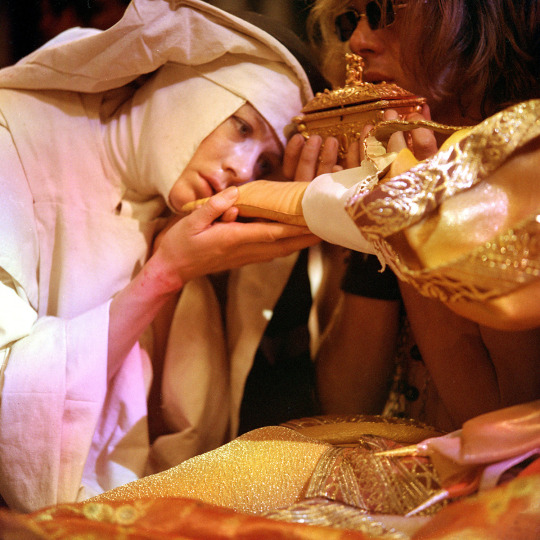
FIlmStruck: Can you tell readers a little about yourself and how you became interested in Ken Russell's work?
Kevin Flanagan: I'm very much of the video store generation, and my first job and academic interests somehow combined to lead me to Ken Russell's work. When I was 15 or so (this would be around 1998, give or take a year), I remember flipping channels and landing on Bravo's "Five Star Cinema" film, a designation they gave to movies whose rights they had purchased. Other films in this strand that I can remember from the time were THE MEANING OF LIFE (’83) and PATTON (‘70). Anyway, in this particular film, there was an extraordinary sequence that'd I'd stumbled into: a man sitting on a train, with a hand on his head, crouched over in repose, while shadows undulated across his face. I continued watching the film. I gathered it was some kind of artist biography, the story of a composer, but I didn't know his music and was overwhelmed by the images, to the point where I could not really retain the plot. Sadly, our regional TV listings guide did not mention the name of the film, so I was not able to go back and watch the whole thing until years later.
Soon after, I got a job at a video store (Hollywood Video) and began working my way through the back catalog. At the time, I was following recommendations from books like John Stanley's Creature Features or various Leonard Maltin guides. I remember reading about (funnily enough) THE DEVILS (not knowing who Ken Russell was) and renting it, only to be blown away. I had no formal film studies training, nor any critical experience beyond amateur reviews, but I recall thinking that the "look" of the film had a lot in common with the mystery film that I'd been searching for. Certain themes were the same—genius constrained by society, persecution over religious belief—and some actors even seemed familiar (particularly Georgina Hale). I decided to watch as much Russell as I could, and within weeks I'd purchased a VHS of MAHLER (’74) off eBay and realized that at last, I'd found the film that had been haunting me for close to two years! I was soon off to college, where I proceeded to take as many film courses as possible, as none had been available to me in high school. I found my way to cinephilia, film studies, criticism and peripheral things like an interest in serious music all through the lens of Ken Russell!

FS: Seeing a Ken Russell film for the first time can truly be a transformative experience and it sounds like his work really made an impact on you. You mentioned that your interest in Russell also led to your interest in music, and I know that classical music is often an essential element of the director’s work. How important is music in THE DEVILS and was Russell inspired by any particular composers while he was making the film?
KF: Peter Maxwell Davies (who composed the music for THE DEVILS) had a close relationship to Russell during this time. Russell produced two Davies records, featuring his Fires of London ensemble, that were released in the UK by the Unicorn label: Vesalii Icones and Eight Songs for a Mad King. He is a composer of avant-garde "serious music" that might now be called "classical". Russell was by now notorious—and beloved, in some circles—for his films about musicians. His most recent biopics of composers were on Richard Strauss (DANCE OF THE SEVEN VEILS [‘70], his last film for the BBC's Omnibus arts strand) and Tchaikovsky (THE MUSIC LOVERS [‘70], a major theatrical film for United Artists), so there is something of their bombast that can be traced to THE DEVILS. But Russell's commission of Davies to do music for THE DEVILS is comparable to his use of Derek Jarman's sets: an unmistakable modernity of detail and dressing, despite enough historically-appropriate elements that do not feel too anachronistic. The music that Davies delivered for the film is angular and angry in a way that is unmistakably contemporary. At times it feels like a Sun Ra improvisation! But the instrumentation is generally period appropriate. So much about Russell's film of THE DEVILS, just like Aldous Huxley's book, walks a fine line between a clear-eyed vision of the past and the inevitable signposting of the present.

FS: Russell wrote the screenplay for THE DEVILS but as you pointed out, it was based on Aldous Huxley’s non-fiction novel The Devil’s of Loudun. Russell must have found common ground with Huxley since they were both radical thinkers who bucked convention. Both men also grappled with censors who wanted to repress their work. What are some of the differences and similarities between Huxley’s original novel and Russell’s film?
KF: Huxley's book is a weird one. It is based on historical issues and people, but it isn't a conventional work of history. It might be thought of as a book of "ideas", in that it has long divergences away from its central narrative and into psychology, philosophy, ecclesiastical doctrine and allusions to the 1940s and 1950s (critics have noted that the book is Huxley's response to HUAC. The author had worked in Hollywood and witnessed what institutional paranoia did to many of his peers). Russell's film is full of ideas, too, but many of them are communicated visually or sub-textually, or through the gestures and camerawork. For example, scholar Christophe van Eeecke has described the film as primarily being a political allegory, and key sequences like the mummer's play that accompanies a character’s execution show the film's capacity to analyze, render grotesque and represent the world in miniature, as an echo to the viewer on its contemporary concerns.

FS: THE DEVILS was heavily edited when it was released and as far as I know, Warner Bros. has never made a complete and uncut edition of the film available to the public. Why do you think THE DEVILS is still being suppressed and do you think we’ll ever get to see a fully restored version of the film?
KF: Film critic Mark Kermode famously tracked down the extant footage of the film's most famous excised bit, the "Rape of Christ" sequence, and you can view it in his documentary HELL ON EARTH (2004). The BFI have released the film in its longest, officially available U.K. form, and this includes material not in the U.S. theatrical release. I honestly don't know why the film has not been restored to its fullest, since it is a notorious work and I'd imagine would certainly do well if marketed to collectors.
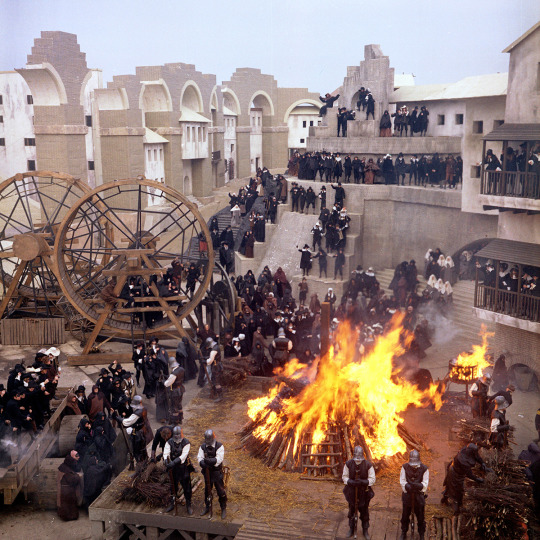
FS: Despite being difficult to see for many years, THE DEVILS has many admirers. It truly is a cult classic as well as an incredible artistic achievement. Why do you think Russell’s film generates such strong reactions and still resonates with so many viewers?
KF: As you say just now, part of the appeal in the pre-streaming era was that the film was hard to see, so tracking it down made it something of a prized object. For its detractors, the film's mix of sadism, religion and sexuality makes it dangerous. For its fans, the exposure of political hypocrisy, the examination of power and the memorable visualization of hysteria makes it essential. In terms of genre, it is an adaptation, a sort of biopic, a nunsploitation movie and a historical film with comedic elements, so it has that unique "cult" mix that characterizes a ROCKY HORROR PICTURE SHOW (’75) or CASABLANCA (’42). One of the best things you can say about it is that it is timely: it was very much of its moment in the early 1970s, but it also spoke to its historical setting and it is still relevant today.
#FilmStruck#The Devils#Ken Russell#Vanessa Redgrave#Oliver Reed#cult film#StreamLine Blog#Kevin Flanagan#Kimberly Lindbergs
159 notes
·
View notes
Text
Yellowface, You’ve Got The Cutest Li’l Yellowface…
Yellowface -- and its illegitimate cousins black-, brown-, and redface -- carts a long and dishonorable history.
Too often racial impersonation is at the service of racism: Minority actors simply rejected sight unseen by audiences and casting directors.
Occasionally it is a little less offensive; there’s at least an attempt to portray the minority character benignly.
Charlie Chan is the most notable example, with the four actors playing him in the sound era all being whites using tinted skin and eyefold appliances.
Chan was intended as a positive role model, and watched in that context the movies are not consciously insulting.
But in a wider context, casting against ethnic or racial type is fraught with danger.
On stage, where a multi-ethnic cast may play the Scots of MacBeth or the Thais of The King And I or the Ozark hillbillies of Li’l Abner, the sheer artifice of theatricality allows audiences to overlook casting against ethnicity.
Patrick Stewart famously played Othello against an all African-American supporting cast, and stage productions where multi-ethnic casts play biological family members are readily accepted.
But film and TV impersonations (with the exception of comedy skits that play towards theatrical tropes) are supposed to be real and convincing. Trying to pass off any performer as a different ethnicity, particularly a significantly different one physically, risks alienating a huge portion of one’s audience.
But…it can be done…if one earns it…and The 7 Faces Of Dr. Lao earns it.
It is not a universally loved film:
It’s corny and derivative and producer / director George Pal steers the production with an unsteady hand, but it also possesses heart and soul and more than a little philosophy that turns out to be surprisingly profound.
If you love it, you’re going to really love it. If you’re going to stub your toe on the clunky parts, there’s a lot of clunky parts for a lot of toes.
So, is Tony Randall’s turn as Dr. Lao + 6 other characters an acceptable case of cultural appropriation / ethnic impersonation or not?
Well, consider…
In the context of the story Dr. Lao is a quintessential Trickster come to a remote American West town to teach the good -- and not-so-good -- citizens a thing or two. As a Trickster, he employs a variety of methods to divert attention and deflect questions, including a grab bag of voices, accents, and dialects. He speaks most often in refined, flawless, unaccented English, but switches to sing-song “Chinee” pidgin when people start getting too inquisitive. Exactly who he is could be anyone’s guess since most of his cultural references are European and Greek while his few Asian references are dismissed as lies and fabrications. So for an Asian character to be portrayed by an Anglo-looking Jewish-American actor works in the story itself since Dr. Lao as a character is shown to be a fictional construct overlaying the real yet still hidden persona.
In the context of the film, Randall the actor plays a wide variety of human and non-human characters: Dr. Lao (presumably Asian, not necessarily human), Merlin (Anglo, human), Apollonius (Greek, human with disability), Pan (Greek, non-human), Medusa (Greek, non-human female), The Abominable Snowman (Asian, non-human), and the voice of The Great Serpent (Biblical, presumably Middle-Eastern, non-human). (Randall also appears in a one-shot cameo sans make-up as a spectator at Dr. Lao’s circus.) So the film sets itself up as the kind of movie where part of the deliberate artifice is that one actor will play multiple characters and actively invites the audience to search for him among the rest of the cast (the irony being that The Abominable Snowman in the film was played by a bodybuilder made up to look like Tony Randall wearing Snowman make-up; Randall only donned the make-up for publicity photos). From that perspective, Randall could have been replaced by any comparable actor of any ethnicity or gender and the end result would have been the same.
In the context of theme, transformation and illusion are crucial foundations upon which the story is built, with several characters loaning their appearance to others (including a sea monster that sprouts 6 extra heads, all of them characters Randall played). And this does not touch on transformations of heart and soul and mind and body that also take place, nor does it take into consideration that Dr. Lao never appears in the same shot with any of the other characters, suggesting all of them are really him (in fact, except for the Abominable Snowman pulling The Great Serpent’s cage in the parade and the aforementioned sea monster scene, none of the characters played by Randall appear together). The possibility that anything and everything is either malleable or an illusion permeates the film and calls into question whether Randall’s various performances themselves are self-referential to this theme.
The 7 Faces Of Dr. Lao is based on Charles G. Finney’s novel The Circus Of Dr. Lao and bears the same relationship to its source as the film L.A. Confidential shares with James Elroy’s novel (i.e., same theme, and several characters and plot points port over, but otherwise totally different).
The screenplay is credited to Charles Beaumont but how much he actually contributed is in doubt. Beaumont, a prolific short story and TV writer in the 1950s, suffered a severe physiological and cognitive decline in the early 1960s. Many of his post 1963 credits were actually written in part or in total by writer friends who wanted to ensure his wife and children received health care and residuals after his death.
Most of the script is probably the work of Ben Hecht, the incredibly prolific Chicago crime reporter turned novelist / playwright / movie producer. Hecht, well known for 1930s gangster films and screwball comedies, also possessed a taste for the fantastic and macabre (read his novel Fantazius Mallare for a sample of his imaginative writing). He died in 1964, shortly after The 7 Faces Of Dr. Lao’s release, but screenplays he’d written or worked on continued being produced for decades after that.
When work on the screenplay started is unclear. Hecht’s style seems more in tune with Finney’s than Beaumont’s, but Beaumont in his prime would have been an excellent choice as an adaptor.
The 7 Faces Of Dr. Lao addresses the issue of racial prejudice quite directly, and while all three writers involved are known for their firm stands in favor of racial equality, to me the final flourishes belong to Hecht. Early in the film one grizzled old Western character wonders if Dr. Lao is “a Jap” and is immediately corrected by one of his friends who correctly identifies Dr. Lao (or at least the clothes he is wearing) as Chinese. When asked how he knows this, the friend replies: “Because I ain’t stupid.”
Through out the film there are examples of racism and racial prejudices being confronted and confounded, and by the end even the chief antagonist has come to change his ways.
Producer / director George Pal holds a venerated place in the history of fantastic cinema, but his own career was dotted with racially problematic works. Pal, a Hungarian animator who brought his Puppetoon films to Hollywood, did not harbor the racial animosity of many white Americans, but his visual style was influenced by American stereotypes.
Pal made several short films featuring a character named Jasper, based on African-American culture as seen through white eyes. One can look at those films and tell Pal did not make them with malicious intent, but unintended stereotypes sting just as badly as deliberate ones.
To his credit, Pal responded to criticisms of the Jasper shorts by making John Henry and the Inky Poo, using more physiologically accurate puppets to depict the legendary African-American folk hero.
When Pal segued into live action feature films, he tended to avoid racial issues by avoiding racial minorities. Conquest Of Space featured a Japanese astronaut but When Worlds Collide shows only white people surviving the end of the world. The Naked Jungle’s white plantation owner browbeats native workers into fighting off a massive swarm of army ants, and Pal’s last film Doc Savage tried to recapture the feel of 1930s pulp adventures but unfortunately dredged up native stereotypes of that era as well.
Pal’s feature career is rather uneven:
When he made a good film it was really good, when he misfired it was a resounding dud. The 7 Faces Of Dr. Lao marks the beginning of the end of his active career. It faltered at the box office and while it shows he clearly wanted to move into more mature, more thoughtful films, his family friendly reputation trapped him. It took him four years to produce his next film, The Power, an edgy for the era sci-fi thriller, then seven years after that for his last movie, the remarkably unappealing Doc Savage, a kiddee matinee pastiche.
Back to the issue of racial impersonation.
As stated above, it’s very, very difficult to justify racial or ethnic impersonations today. The 7 Faces Of Dr. Lao is one of the extremely rare cases where it can be excused, if not justified, based on the particular (if not downright peculiar) elements of the story and the intent behind them.
© Buzz Dixon
#7 Faces Of Dr Lao#Tony Randall#Charles Beaumont#Ben Hecht#George Pal#Charles G. Finney#fantasy#media#ethics#morality#prejudice#racism#ethnic impersonations#yellowface#philosophy#things of the spirit
2 notes
·
View notes
Text
LGBTQ Light Novel Review - Adachi and Shimamura Vol. 1
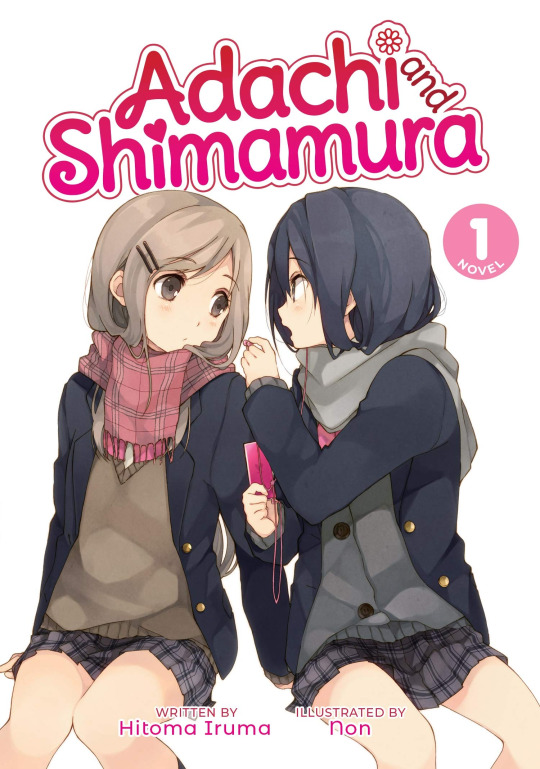
In Yuri, as with most things, what is popular is not always what is good, or rather, the most prolific item is usually successful because of massive marketing and economic power, and rarely because of a work’s merit. That is not to say that just because something is beloved, it is a bad work, far from it. It is nearly impossible to achieve commercial success if the content is terrible, although NTR Netsuzou Trap challenges this statement. However, the vast majority of the most consumed Yuri series like Bloom Into You and Yuru Yuri are good and even great at times, even if they are not the pinnacle of the genre, despite what sales figures and community polls may tell you. Occasionally the (subjective) best can rise to the top, like Kase-san and My Lesbian Experience with Loneliness, both of which have lauded appropriate praise from critics and audiences.
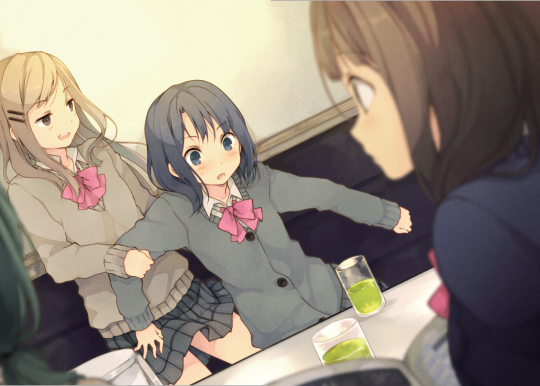
Iruma Hitoma’s Adachi and Shimamura is a well-liked and successful series, publishing eight volumes over the past seven years, spawning two manga adaptations, and receiving an anime adaptation, which currently scheduled to premiere later this year. The light novel finally makes its English debut, and I found the first volume, sadly, disappointing. There are some lovely moments, and I understand why this series is so widespread, but far too much of the material felt aimless, unnecessary, or even aggravating. Give me a few hours and an X-Acto knife (or the copy-paste tool, considering this was an early digital release), and I could probably salvage a pretty good short story from the unfortunate drudgery that is this light novel. Still, as a whole, it would rank significantly far beyond other popular and frankly superior titles.
The light novel follows two high school girls, Adachi and Shimamura, who are both delinquents that regularly play hooky. The two meet when they both choose the same hiding spot, a loft in the gymnasium, and the two become friends, spending their classtime avoiding other people and playing ping-pong in the loft. This concept quickly wears thin as the author feels the need to drill it into the readers’ skulls over the first two chapters. Eventually, the actual plot, if you could call it that, takes over, and the rest of the volume follows the two girls on their inconsequential adventures, going to the mall, fishing, and singing karaoke. Now, there is nothing wrong with a relaxing slice of life about girls doing everyday things, but Adachi and Shimamura utterly fails in this endeavor.

There is a semblance of a narrative arc, but meaningless occurrences so muddle it. After almost every scene, I found myself asking why it was included, what the point was, what the consequences were, what effect it had on the overall story, and there was hardly ever an answer. Sure, there were cute moments, like Shimamura riding on the back of Adachi’s bike or the two girls holding hands which one can squeal and throw money at, but it all feels so distracting. These inadequacies are made all the worse because the story underneath all the garbage is actually rather enjoyable.
Chapter Three, “Adachi, Questioning” is a definite highlight of the story. This section sees Adachi having a salacious dream about Shimamura and struggling to come to terms with it and her feelings. Her inner conflict includes some pleading and self-assurances she is not gay. This assertion quickly begins to shatter as she struggles to control herself. This chapter is realistic, if a bit sensationalized, and captures that awkward teenage lesbian experience perfectly. If one reads only this chapter and a bit of the start of the novel for context, you will find a fantastic story.
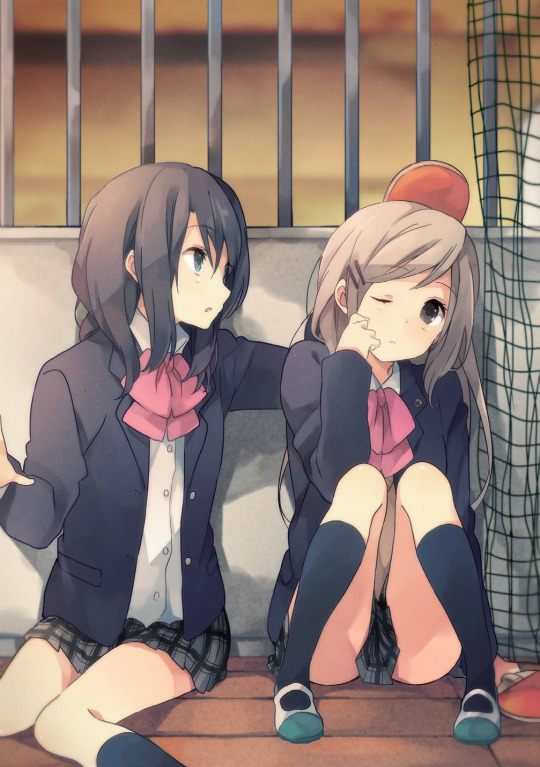
Another feather in this series cap is Iruma’s prose, translated by Molly Lee. The light novel reads exceptionally well, with varied and complicated writings, raising it above most other light novels whose composition I struggle to identify alongside my elementary students’ writings. The perspective shifts back and forth between the title characters every chapter or so, providing readers with a nice bit of dramatic irony, as the girls wonder about the other’s actions or thoughts. Such moments are the only time the author shows us any sense of logic or consequence. My only complaint with the prose is the over-reliance on narrating the characters’ thoughts. These comments are usually sarcastic and used for comedic effect but become a bit tiring.
The story may be thin and convoluted, but the characters are at least consistent. Sadly, they are consistently terrible, ranging from unlikable to downright annoying. Both Adachi and Shimamura are incredibly antisocial, with the former being somewhat more anxious and closed off. Neither one has any ability to connect with other people beyond awkward conversations or snark. At more than one point, Adachi actually runs away from an uncomfortable situation. Their introversion does not read well. Both girls come off as cold and unkind, not touching, cute, or relatable. I cannot fathom what they possibly see in friendship with each other, and this is a serious failing on the author’s part. But nothing, no aspect of their character, could possibly make them worse than Chikama Yashiro.
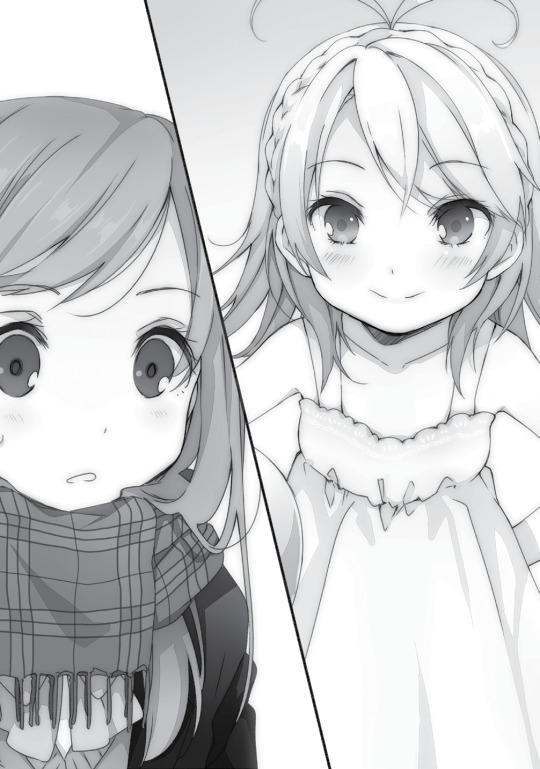
Yashiro is a small time-traveling alien from the future who forces her friendship on Shimamura. If that sounds awkward and out of place here, do not worry, it does in the book too. No other character indicates any level of fantasy. They at least maintain a semblance of reality even if their personalities are unrealistically callous. Yashiro feels like a strange addition from a fanfiction. Not only is she out of place with the rest of the story, but she is aggressively bothersome. On more than one occasion, she forces her company on Shimamura and loudly interrupts the already struggling plot. The worst of these incidents occurs when Adachi finally gets Shimamura to agree to an outing together at the mall, only to have a bratty alien impose her company on them. In the end, the only emotion the girls feel which Iruma manages to convey is anger and annoyance, as readers will be nothing short of fuming after reading chapters about the bothersome creature.
Adachi and Shimamura is a resounding disappointment. There are individual moments of cuteness, none of which have meaning, and one chapter with some actual stakes and engaging story. Other works, like Yuru Yuri, have shown that inconsequential slice of life stories can thrive with engaging characters and fun situations, but Adachi and Shimamura has neither. However, I still have some hope for the upcoming anime adaptation. Crazy and annoying antics like Yashiro’s will likely come across better in a visual medium, where characters can be reactive and exaggerated better than in text. Further, I think the additional dialogue required by television will help the girls feel less distant and more engaging for the viewer. I recommend you skip reading this book and wait to see if the anime has anything more to offer, or if future volumes can improve the shoddy storytelling.
Ratings:
Story – 4
Characters – 2
LGBTQ – 6
Sexual Content – 1
Final – 3
Purchase Adachi and Shimamura Vol. 1 here: https://amzn.to/3alTyLM
Review copy provided by Seven Seas Entertainment
#yuri#reviews#lgbt#lgbtq#adachi and shimamura#light novel#manga#anime#girls love#gl#wlw#gay#romance#lesbian#lgbtq+#queer#seven seas#comic#comics#lesbian comic
237 notes
·
View notes
Text
The Juniper Tree
Every woman ought to know that fairy tales are not to be trusted-especially not those (re)written by The Brothers Grimm. Thankfully, Nietzchka Keene's The Juniper Tree returns this tale to its rightful place: as told from a woman's perspective, as too often, they are not. Anyone who has read Clarissa Pinkola Estés' groundbreaking "Women Who Run with The Wolves" will welcome this feminist interpretation of what (in the Grimms' hands) is actually an incredibly misogynist, violent, cautionary tale against brave little girls who dare disobey. And anyone who hasn't yet, should-especially the many critics attempting to analyze and canonize Keene's film in relation to the works of her more familiar male peers (e.g. Bergman, Tarkovsky, or Vláčil) whose films bear only aesthetic resemblance to what is otherwise a truly original modern gothic masterpiece. It seems appropriate that this film should re-emerge now, after so many years of being unappreciated or misunderstood, lost in the shadows of the zeitgeist. The Juniper Tree, like the rapturous and recently re-released work of Hilma af Klint, was -alas- ahead its time.
I'll admit, as with likely most viewers, it was the prospect of seeing Björk in her on-screen debut that caught my attention. Björk plays Margit, a young woman, who, along with her older sister, Katla (Bryndis Petra Bragadóttir) is forced to flee into the wilderness after their mother was accused of witchcraft and killed. Katla encounters a single man living alone in the wild. They fall in love, and the sisters are invited to move in- with him and his young son, the product of a prior marriage. The boy immediately resents Katla, fearing that his new stepmother will replace his own, now long dead and buried under The Juniper Tree. However, he grows to trust and befriend Margit, who meanwhile struggles to control and interpret her own ecstatic visions- for fear that she, like her mother, may be accused of witchcraft. The boy's resentment festers and escalates. He spurns Kata's attempts to connect with and care for him. His father likewise falls prey to doubt and paranoia, now caught between conflicting feelings of loyalty to his son, desire for love, and guilt for his desire. Everybody feels threatened -everyone except Margit, the only one able to see through all the reactionary behavior to the truth of the matter. This guilelessness, however, gets her into trouble. And therein lies the true moral of the story, ladies: Beware your own ability to think and see clearly, when those around you cannot.
Beyond the pleasures of watching a young, "undiscovered' Björk perform, the film has so much more to offer in the way of story, cinematography, and-my god--the sound! The sensual and evocative images, actions, and landscapes are more than enough to keep you hooked, all the way to the end. Come for the Björk, yes, but stay for the Keene. I'm embarrassed not to have known her till now. Ill cast as wide a spell as I can: Nietzchka Keene. Nietzchka Keene. Nietzchka Keene Originally published March 9th 2019 in Screen Slate.
Angeline Gragasin is a NYC-based writer, filmmaker, and artist who tells stories about ecology, memory, and power. You can learn more about her and her work at www.angelinegragasin.com.
Personal Reminiscences of The Juniper Tree
by Patrick Moyroud
I met Nietzchka Keene at the UCLA film school, when we were both graduate students. She and I both had an interest in the use of sound to enhance and support the visual elements in film. We worked together mixing soundtracks for each other's film projects, and recording novel and authentic sound effects. It seemed to us that soundtracks were often left until the last stage in production, and suffered from a lack of complexity and originality. We spent hours recording just the right sound of a body falling to the ground, or some barely perceptible ambience in a forest far from the city.
Nietzchka's early films contained many elements of the mood, structure and composition seen in The Juniper Tree: barren, bleak landscapes, mysterious characters with conflicted motivations, and ambiguous endings. One could also say that they took place in a different universe, where time and location were less important than mood and ambience, which worked together to dissociate the viewer from any hint of reality.
Prior to film school, Nietzchka's major at UCLA was folklore, an important element throughout all her work, and which added to the timeless nature of the stories. Her last two features, Heroine of Hell and Barefoot to Jerusalem, continued the same themes. Juniper was shot in Iceland during the summer of 1986, at a time when the country was barely on the tourist circuit, let alone a major filming location. The script is based on a Grimm Brothers story of the same name. Nietzchka spent a year in Iceland beforehand, exploring locations, studying the folklore and history, and selecting the cast and crew.
From the very beginning, the project was an adventure. The Juniper Tree could easily qualify as a low-budget film, although today it might be called micro-budget. Nonetheless, Nietzchka and her cinematographer Randy Sellars managed to create hauntingly beautiful imagery. The location challenges were many. We brought the Arriflex camera from the US, and most of the lighting equipment from France. There was only one generator truck in the whole country - an antique van that provided just barely enough power. The maritime climate was unpredictable, and the wildlife - mostly sea birds - objected strongly to our presence by bombarding us as we shot scenes near their nests.
In spite of all the difficulties, or perhaps because of them, we persevered and eventually completed the filming in about 4 weeks. I believe that the camaraderie, passion, and determination of our small cast and crew contributed much to Juniper's successful completion. Sadly, Nietzchka left us in October 2004, with several finished and unfinished scripts waiting to be produced. While we may never see what other great films she had in her mind, at least we can be happy in knowing that this one will continue to honor her memory. I hope you enjoy it.
"I made what was in my heart, essentially" — Nietzchka Keene
Patrick Moyroud was the associate producer of The Juniper Tree.
A Visionary Rediscovered
by Amy Sloper
The reintroduction of The Juniper Tree follows a familiar path, playing in many of the same cities and venues that it screened in during the film's initial release 1989. The first time around, the film was commonly seen at women's film festivals, with filmmaker Nietzchka Keene on hand for introductions and question and answer sessions. Now the film is on a restoration circuit, often with a member of the restoration team or an original crew member on hand to introduce audiences to what they are about to see. The individual attention given to the film at each stage, by the filmmakers, the programmers, the audiences, and the restoration team, seems wholly appropriate for a film whose meditative and mystical quality was out of keeping with the mainstream industry's expectations both then and now. It is sadly not surprising that for a period the film and filmmaker were all but forgotten, along with many of the other independent films of women during this time period, while its artistic accomplishments have become only more apparent with the passage of time.
Filmmaker Nietzchka Keene was born and raised near Boston, Massachusetts, receiving her BA at U-Mass, Amherst, and her MFA from UCLA. In 1985 she was awarded a Fulbright Fellowship to Iceland where she wrote and prepared for production of The Juniper Tree, returning to shoot the film in 1987. It was the first film to star the well-known singer and actor Björk (billed at the time as Björk Gumundsdóttir), in the role of a young child in a story based on a fairy tale from the Brothers Grimm. Keene won a Verna Fields Memorial Scholarship from UCLA in 1987 to edit The Juniper Tree, completing it in 1989. In 1995, after a long tour with the film, which screened at over 23 festivals worldwide, Keene began her tenure as a professor at the University of Wisconsin-Madison teaching filmmaking, where she remained until her death at the age of 52 due to cancer.
Keene's entire archive was donated to the Wisconsin Center for Film & Theater Research, a significant film archive on the UW-Madison campus, with the intention of making it available for future scholarship. This is where the only print of The Juniper Tree was known to exist prior to this restoration project, alongside the picture negatives and original sound elements for this and all of filmmaker Nietzchka Keene's other work, which include three short films she made while a film student at UCLA - Friends (1977), Still (1978), and Hinterland (1981) - a 1996 television movie, Heroine of Hell, starring Catherine Keener and Dermot Mulroney, an animated short in 1998 called Aves, and her unfinished feature Barefoot to Jerusalem, which was shot in Madison, WI and the Upper Peninsula of Michigan.
I was an undergraduate studying film at UW-Madison in the late 1990s, and Nietzchka was my advanced production professor. She made a strong impression, particularly with regard to the need for an unforgiving nature in the pursuit of a vision. As her longtime friend and the producer of The Juniper Tree Patrick Moyroud put it:
"She had her own ideas and goals for what she wanted to accomplish and would follow them with intensity and strength. Sometimes that meant stepping on toes ... not many people have produced, written and directed three feature films on budgets that would not even pay for a three-bedroom house today?
Nietzchka was instrumental on my path from Madison, writing my letter of recommendation to UCLA's newly established program in Moving Image Archive Studies in 2003. From there I followed a path very similar to hers, first to positions working with film and video collections in Los Angeles, then to Massachusetts working at the Harvard Film Archive. In 2014, I returned to Madison to head the film and video collections of the Wisconsin Center for Film & Theater Research, where I was very humbled to be managing Nietzchkas collection alongside the materials of Shirley Clarke, Jill Godmilow, the United Artists studio, and Emile de Antonio, among others. I was also startled to hear that the single print of The Juniper Tree - at that time the only print we knew existed - had been loaned out to venues as far away as Australia. Visions of the print getting lost in transit or accidentally being damaged by a venue rattled my brain. At the same time, I was thrilled to know that there was sustained interest in the film, and knew that we needed to find a way to make new film prints and digital screening copies available so we were not taking unnecessary risk with the single existing print.
A restoration project for a feature film can cost into the six figures, and with no internal budget for preservation work at the Center for Film & Theater Research, I teamed up with restorationist Ross Lipman, well-known for his restoration work on American independent and experimental cinema as well as his own work as a filmmaker, and also a mentor and collaborator since my days at UCLA. We approached The Film Foundation, the non-profit founded in 1990 by Martin Scorsese to support the preservation and restoration of cinema. At the time, The Film Foundation was interested in establishing relationships with smaller film archives, lucky for us, so we worked to establish a relationship for The Juniper Tree project. Another stroke of luck, The Film Foundation was also expanding their funding specifically to work on the restoration of work by female filmmakers. The final stroke of luck was working with Kris Merola at The Film Foundation, who gently guided us through the grant writing process. Ross and I worked on the grant in tandem, with Ross to manage all of the lab work on the ground in Los Angeles. The restoration proposal was funded in 2017 from The Film Foundation and The George Lucas Family Foundation. The restoration and re-release of The Juniper Tree is a triumph that required dedication from so many partners, from Nietzchka and Patrick Moyroud who took such good care of the film materials all along, to the archivists of the Wisconsin Center for Film & Theater Research from 2004 onwards who performed the rehousing and cataloging work to make the collection discoverable (and continue facilitating research access to this day), to The Film Foundation and The George Lucas Family Foundation for generously funding the restoration, and finally to Ross Lipman and all of the staff at the labs he worked with on the analog and digital restoration.
The belated recognition Nietzchka Keene is receiving for her previously under- known masterpiece is made all the more significant by The Juniper Tree's powerful evocation of the cultural isolation of visionary women. It is shocking how a film so recent and so powerful can be forgotten so quickly - an error we hope to rectify with this new restoration.
Amy Sloper is the Collections Archivist at the Harvard Film Archive.

About the Restoration
Arbelos release of The Juniper Tree has been fully preserved in 35mm and remastered to 4K digital Video by the Wisconsin Center for Film and Theater Research and The Film Foundation, with funding provided by The George Lucas Family Foundation.
Photochemical picture source was the original 35mm BW picture negative A & B rolls. These were used by Fotokem as the source for a fully timed 35mm answer print, release print, and preservation fine grain master positive.
In parallel to the photochemical work, the original 35mm BW picture negative A & B rolls were scanned in 4K on a Lasergraphics ScanStation, and digitally reconstituted, cleaned up, and graded at Muminate Hollywood. The 35mm films natural grain has been left untouched. The black-and-white grading was approved by cinematographer Randy Sellars.
Sound source was the original 35mm magnetic soundtrack mix, which was captured and remastered at Audio Mechanics, Burbank.
All preservation elements, film and digital, are in permanent storage in Wisconsin.
Restoration Supervisor: Ross Lipman
In consultation with: Amy Sloper, Patrick Moyroud, Randy Sellars
DI Colorist: Andrew Drapkin, Illuminate Hollywood
Film Scanning and Digital mastering: Illuminate Hollywood
35mm film printing: Fotokem
35mm grader: Doug Ledin, Fotokem
Audio Restoration and Mastering: John Polito, Audio Mechanics.
Special Thanks: Steve Wiener, Bill Tayman, Kim Young, Andrew Oran, Simon Daniel
Production Credits
Producer: Ei Toshinari
Blu-ray Mastering: David Mackenzie, Fidelity in Motion
Package Design: Dylan Haley
Subtitles: CMI Media Management
Co-CEO, Distribution: David Marriott
Co-CEO, Post-Production: Craig Rogers
Chief Strategy Officer: Dennis Bartok
EVP of Strategy: Joseph Kaufman
Chief Business Development Officer: Jonathan Marlow
Special Thanks: Patrick Moyroud, Randy Sellars, Ross Lipman, Amy Sloper, Wisconsin Center for Film and Theater Research (WCFTR), Kristen Merola, The Film Foundation, Mary K. Huelsbeck, Boyd Hillestad, Jeff Feller, Jon Manning, Angeline Gragasin, Jon Dieringer, Screen Slate, Michael Lieberman.
Acknowledgements: Arbelos has thoroughly sought to contact all relevant rights holders and copyright owners. Should any party find that their rights were inadvertently retained, we would welcome correspondence from them.
On YouTube: https://youtu.be/POwG00JWrRo
1 note
·
View note
Text
An exciting new review experience in three parts! It’s gonna be a long one!
It was only a matter of time until I addressed this elephant in the room: I’m a little bit obsessed with To All the Boys I’ve Loved Before — both the Jenny Han novel and the Netflix original movie. And I’m pretty sure I’m not the only one. To All the Boys is the story of Korean-American, high school junior Lara Jean, whose personal love letters to each of the five boys she’s loved are accidentally sent out, all while she’s dealing with the challenges of her older sister leaving for college (and leaving behind an ex boyfriend that Lara Jean has always had an eye for). In an act of mutual damage control, Lara Jean and her former crush Peter Kavinsky enact probably the best (and definitely my favorite) rom-com cliche of all time: they pretend to be a couple.
I received a copy of the book (the first in a trilogy I haven’t read the rest of yet, NO SPOILERS) as a Christmas gift last year, and I read it back around February or March. Now that the Netflix film has taken Twitter the world quite literally by storm, I figured it was time I launched my thoughts right out into the eye of it. So without further ado, here’s everything I have to say about To All the Boys I’ve Loved Before, presented in three parts.
To All the Boys I’ve Loved Before: The Movie
When I’m out of town for the night, Matt has a ritual where he gets a pizza or some snacks and watches a movie I wouldn’t like with the cat. Last week, on a night when Matt was going to be out late and my cat and I were home alone, I decided to do the exact same thing myself (except now I’m pretty sure that he would actually enjoy this movie too). Actually, there are a lot of reasons why this movie is good for EVERYONE, even us “grown ups.” I was feeling a little down on that particular day, and I needed something lighthearted and a little bit indulgent to get my mind off of it, so I put on To All the Boys, because even though I knew I wanted to watch it, I’d been putting it off, in a way.
While some nights since its premier I just didn’t have the time to sit and watch a whole movie, hype scares me away from things. Not in a hipster sense of “If too many people like it, then it must not be good,” but I fear the bandwagon effect. I don’t want to like it just because other people do and I want to fit in. But I have nothing against liking something popular if I actually connect with it. With this movie, I was actually expecting it to be a little cliche, a little cheesy, and a little silly, but in all actuality, it’s just the best rom-com I’ve seen in a really long time. Seriously.
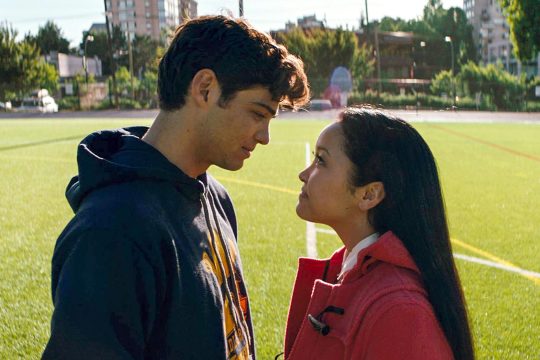
The casting, the characterization, and the pacing all impressed me in their own ways, but what actually stood out to me about the movie was the cinematography and the storytelling choices. I’m not pretending to know anything about movies, but this could have easily been a movie that focused on the plot to give the people what they want: ROMANCE. While that’s still the main focus, the creative direction of the movie really surprised me with the handling of all the side conflicts circling around the main arc. Visually, it was way more interesting than you’d expect from a rom-com: the shots are interesting, and a little bit conceptual, and all meant to capture Lara Jean’s state of mind, not just what she’s doing or what she looks like.
I also give the movie huge props for something a lot of teen movies weirdly fail at, which is writing dialogue that actually sounds the way teens talk. There was no awkward slang, no overly-rehearsed sounding monologues, and even Kitty sounds appropriately mature for her age without going overboard. Even with it’s modern inclusion of social media, To All the Boys actually nailed it in the dialogue department.
I’ve only got one real bone to pick with the writing overall, and that’s the scene in the first act of the movie that, in my opinion, pretty obviously gives away the twist at the end. I read the book; I knew what happened already. But for someone that didn’t, I think they showed their hand too early. (Notice how I’m speaking in generalities to avoid spoilers). The reveal wasn’t explicitly stated, but I think it was too heavily implied. What Kitty says on the couch is enough. If there was a way that the dramatic irony of us knowing the secret that Lara Jean doesn’t could have enhanced the movie, I would have been all for it, but I don’t think they pulled that off. But this is still a small enough gripe not to ruin the movie for me.
And one more thing: the movie didn’t treat really any character as merely an expendable plot device. Lara Jean is and incredibly well-developed protagonist who I came to love almost immediately (how couldn’t I when she daydreams in regency-era period dress?). But the important thing is that we never stop learning about her; not all the information is dumped into exposition, we have to earn our full understanding piece by piece. While I did feel that Gen was reduced a little bit to the “mean girl” stereotype, we do eventually find out why she acts the way she does, and it’s actually a game changer, if only subtly. (Actually, it’s my opinion that the movie needed more Chris, too.)
This is also part of what makes Peter K. such a great character in his own right, not just as “the love interest.” What’s refreshing about Peter is that he’s a softer form of masculine lead that we don’t see too often, but the kicker is that he’s not afraid to show it from the very start (and to be honest, I didn’t get this as strongly from Book Peter). No “tough guy” layers to dig through—his heart’s pretty much on his sleeve, even though he’s still the cool guy all at the same time. Plus, Noah Centineo is a dreamboat (we were all thinking it). I’m telling you, he’s going to be the Chad Michael Murray of his time.
This is unfair and their outfits match.
While of course there wasn’t time for book-length dives into every character, even Lara Jean herself, the characters were portrayed in a way that encourages the audience to make a connection.
https://twitter.com/ivyjune12/status/1037885481302847488
I’m a firm believer that a movie is not a book. Obvious, but what I mean is that a movie doesn’t just have to be a direct retelling of the book in exact detail. In my opinion, if that’s all a movie does, it was unnecessary. I did all that in my head already. What I think makes a great movie adaptation is that it has to have something to say, some interpretation of the characters, plot, and themes, while still capturing the overall idea and spirit of the book from whence it came. I understand the cuts that were made for the sake of real-estate (though I’m hoping a certain deleted kiss surfaces in the sequel I’m praying for). What they did was tailor down the story to make it more self-contained, more refined, and more to the point so that it fit the medium and told they story it needed to tell while really letting us live inside Lara Jean’s head for a while.
But also, how much do you think Subway paid for that product placement?
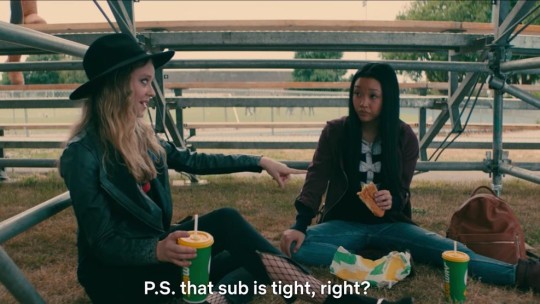
To All the Boys I’ve Loved Before: The Book
You’ll have to excuse my copy of the book, for it has the leftover residue of a “soon to be a major motion picture” sticker that didn’t quite come off all the way. Switching gears, To All the Boys I’ve Loved Before by Jenny Han is just about everything you want in a YA read: a quirky, relatable (and diverse!) main character, a pseudo-love triangle with ~nuance~, and a family secret or two threatening to fracture some relationships when it erupts. I’d known about the book for a few years (thanks, Tumblr), and I made pretty short work of it once I actually had a copy in my hands. The romance arcs made it a page turner in a lot of ways, with the way they criss-crossed and changed shape and came to a heated point.
That being said, I found the book itself a little slow in places in terms of pacing. It’s on the longer end of the YA spectrum, and while I can’t say I ever lost interest, I got a twinge every now and then when I finished a chapter without learning anything new, per se.
My other issue had much ado about Margot, Lara Jean’s older sister, who, despite not being present for the majority of the story, never truly leaves us. I completely understand why Lara Jean thinks of Margot often: she misses her sister, is distressed about keeping the secret, and worries that she’s not ready to fill Margot’s shoes as a caretaker. But in the book, Lara Jean is so preoccupied with Margot that I have to admit that there were moments I was sick of hearing about her.
What I loved most about the books was that Lara Jean’s romance was surrounded by several subplots dealing with friends, family, responsibility, family, and growing up. While a movie only has so much time before it loses us to sleep or boredom, a book can go on, night after night, expanding the main character’s world that we’re lucky enough to be living in. In the book, we get to see a lot more of what Lara Jean’s mom, and her Korean culture, means to her. We also get to see a lot more of how her family has grown from the past until now, and how they’ve all taken on changes before and after Margot’s departure. And maybe the thing I was the most heartbroken about was the letter in Margot’s desk and all the implications it held. Lara Jean wasn’t the only one with a secret, and I love the complexity it added to the sisters’ relationship.
https://twitter.com/ivyjune12/status/1037856493410897920
If you’re wondering about that Tweet, I was quickly disappointed and then overcame it.

Moving on, I’d be so interested to see what more movies would do with the material we have, because there’s a choice to be made at this point: do they go back and pick up the conflicts they didn’t have time for the first time around, or do they move on to whatever new ideas are hidden inside books 2-3? No matter what happens, sequel or not, the movie has actually really nudged me towards picking up the rest of the series—something I wasn’t totally convinced (Peter Convince-sky? No, but A for effort) I’d do before.
2 Outfits Inspired by Lara Jean Covey
I saved this little bonus section for last, mostly just to amuse myself. It was impossible not to notice how amazing Lara Jean’s style was in the movie; every outfit was a SENSATION and I haven’t stopped thinking about a single one. So, for giggles, I dug around in my closet and came up with the two closest Lara Jean outfits I own.
https://twitter.com/gicatam/status/1035720646196510720
1. Skirts and Stripes
A tried and true Lara Jean combo, a button front skirt paired with a cute (often striped) top can be found during a few scenes in the movie, but I would say I came closest to the airport outfit. While my color scheme is off, the spirit is there: I even braided my hair as much as possible. Fun fact: I am a cartoon character who owns this shirt in two different colors, and these boots are old enough that I can ~almost~ call them vintage (not really).
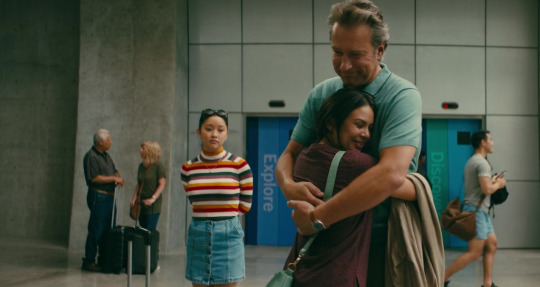
2. The Pink Power Suit
All right, it’s not a suit, but the soft pink blazer paired with skinny black jeans and a black choker was almost certainly a confidence move for the first ride in Peter’s Jeep. I don’t wear this pink blazer enough, and I wasn’t sure if I’d love it with this outfit because it’s more of a salmon than a blush (I want to introduce my best friend Squidward to everybody in town wearing a salmon suit). Actually, this combo worked out surprisingly well, minus the fact that I’m wearing a literal shoe string as a choker.
Actually, I’ve left the house wearing it like that before, and I love it. Fight me.
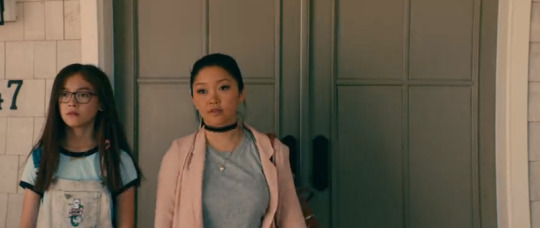
^This is the best image I could find of this outfit and I’m bummed about it.
Lara Jean’s style is the perfect combination of vintage revival and current trends, which is really everything I want to be in my life. I’m already making my list of things I need to add to my own closet: a yellow beret, a lot more bomber jackets, a gorgeous red ballgown. Maybe by the end of autumn, I’ll have the full collection. From now on, every time I go shopping, I’m doing so with the motto: “What would Lara Jean wear?”
If you made it to the end of this post, I salute you. Know of any other books/movies with outfits I should try and copy?
To All the Boys I’ve Loved Before: Movie, Book, and 2 Lara Jean Outfits An exciting new review experience in three parts! It's gonna be a long one! It was only a matter of time until I addressed this elephant in the room: I'm a little bit obsessed with…
2 notes
·
View notes
Text
some thoughts :]
my god. i haven’t written anything this coherent that wasn’t purely informative in ages. 7.2k words so far, which for me, just... whew. that’s a lot. And that’s like, proper fanfic too. Admittedly Secret’s doc where I write down anything and everything is above 10k by now but it is pointedly not actually a story. This, on the other hand, is actually sort of presentable.
Yesterday was the first day I didn’t even open FFXIV and I don’t even know how long. Just spent the whole day writing and revising and looking at social media. The story is indulgent as hell, and sort of messy. Who needs individual scenes when you can just have characters banter for an eternity? Much more fun that way. It’s fine, though. That’s what I started this for, because I wanted to see some characters interact. I’m just glad I didn’t burn out on it before I even began.
Still, a bit embarrassing. 1st person present, a veritable self insert, although the mc is the WoL, referred to ambiguously. What personality they do show is actually based off of Doran, my alt, because having him go through the BRD quests is adorable, but there was little cause to name particulars about him or refer to him by name, and I always get mad when a fic that could have been a perfectly fine ambiguous WoL sort of deal is spoiled by one or two mentions of a name or race.
But anyways. It is INCREDIBLY corny. Elaborating on the relationship between Guydelot and Sanson and the WoL. I just love seeing Guydelot and Sanson going at it, there’s even the setup in canon with the mention that they fight like an old married couple. Adding a snarky bard WoL into the mix just makes things better. Also bonus points for me finding the opportunity to show Tataru and the WoL being friends, and having the WoL pick on Emmanellain.
The only real uh. Difficulty so far is that I am, distinctly, Not A Gay Man. I’ve also never so much as held hands with anyone. I also do not read romance novels. Basically the whole thing reads imo like a cheap visual novel which is my closest comparable experience. Or more appropriately, bad fanfic, which... fair! I haven’t written ship stuff since... actually never. Yeah, not even in middle school, unless you count cannon relationships in Warrior Cats lmao.
As I said, completely indulgent. I enjoy seeing three idiots who are bad at feelings duking it out on the emotional battlefield. I could write silly dialogue for an eternity. Sanson, so far, has only made an appearance in the story’s intro so far though the mention of him is used to push Guydelot’s buttons. It’s primarily just been Guydelot and WoL flirting with each other, and interacting with a few side characters, and I’ll be honest, I didn’t actually think I had a humorous bone in my body. But man. I think I wrote Guydelot well enough. Can’t wait until I can actually reintroduce Sanson, and we can get back to Feelings. WoL and Guydelot are open enough, even if the latter isn’t so with his feelings for Sanson, Sanson himself is just wound so tight. Writing him as a blushing angry mess at his own feelings is hilarious.
A bigger highlight out is this so far, however, is the sequence where WoL and Guydelot perform a duet, and I got to solve the funny problem of how to write a song without writing a song. The answer was to describe its contents and the room’s response with what is an attempt at lyrical prose. It’s not bad. Could certainly better though. And I’m not sure anyone other than myself would enjoy reading this?
Sorta goes for the rest of it, too. My writing feels sorta repetitive unfortunately. Though I recognize that I’m not actually that experienced of a creative writer. Do not ask me to describe anything in detail or I will cry. I just want to make my funny little people say funny little words at the moment. Just gotta keep reminding myself that this is for fun, and I’ll get better in time. Not that this particular story lends itself well to detailed imagery anyhow. It’s been incredibly light-hearted so far and not particularly romantic, just two promiscuous bards having a drink and singing a song. Might be more room for it once Sanson is reintroduced. Maybe even more once I do the BRD quests past 56.
Oh, right, that’s what prompted this in the first place! I swear, I haven’t seen anyone in the FFXIV community mention these two, and I haven’t searched out fics of them specifically to avoid spoilers of the BRD quests, since I know they can get quite involved, and there’s at least the current dispute between Sanson and Guydelot, with the question of where the hell Guydelot wandered off to. Well, earlier I spotted a fic involving both of them and an ambiguous WoL while just searching by newest updates, which, yeah, I wanna read that! But again, fear of spoilers and all. And I saw in the summary that there’s a whole Discord dedicated to these two? Not that I have an interest in joining, don’t care much for people who put so much stock into a ship like that, but it’s still good to know that there are people who like them.
Anyways, now that I’ve come to a good break in the story, I can actually stop procrastinating on moving on with Heavansward. Yes, this was also part of that procrastination. I’m gonna get back to it now.
0 notes